
The Navy Department Library
Regulations Governing the Uniform of Commissioned Officers, Warrant Officers, and Enlisted Men of the Navy of the United States
With Plates - 1897
REGULATIONS
GOVERNING THE
UNIFORM OF COMMISSIONED OFFICERS
WARRANT OFFICERS, AND ENLISTED MEN
OF THE
NAVY OF THE UNITED STSATES
WITH PLATES
1897
___________
REGULATIONS
GOVERNING THE
UNIFORM OF COMMISSIONED OFFICERS,
WARRANT OFFICERS, AND ENLISTED MEN
OF THE
NAVY OF THE UNITED STSATES
_____
WITH PLATES
_____
WASHINGTON:
GOVERNMENT PRINING OFFICE.
1897.
NAVY DEPARTMENT,
Washington, D. C., July 1, 1897.
The following uniform regulations are established for the government of all persons attached to the naval service. All regulations, orders, and circulars inconsistent therewith are hereby revoked.
John D. Long,
Secretary.
(3)
[Blank]
(4)
UNIFORM FOR OFFICERS, UNITED STATES NAVY.
_____
GENERAL REGULATIONS
1. All persons belonging to the Navy must strictly conform to such regulations for uniform as may be published from time to time by the Navy Department. Every person belonging to the Navy is strictly forbidden to wear any dress or decoration other than that to which his grade or the law entitles him.
2. Officers on duty on board all ships of war of the United States and on board all receiving ships, Coast Survey vessels, and vessels of the Fish Commission, and all navy-yards and shore stations will at all times wear the uniform of their perspective grades.
3. Officers are permitted to wear plain clothes when on duty at the navy Department, Naval Observatory, Naval Proving Ground, Coast Survey Office, and under the Light-House Board.
4. Officers serving on courts-martial, courts of inquiry, boards of examination, or when attending as witnesses or otherwise before courts-martial or courts of inquiry, shall wear the prescribed Undress A uniform of their respective grades.
5. Officers on leave from their ships or shore installations are permitted to wear plain clothes at the discretion of the senior officer present.
6. Retired officers will be permitted to wear the uniform of their grade as prescribed at the time of their retirement.
7. Officers are prohibited from wearing their uniforms while suspended from duty by sentence of a court-martial or on furlough for punishment.
8. On all occasions of ceremony, when a commanding officer may deem it necessary to order the attendance of the officers under his command, he will prescribe the uniform to be worn.
9. Officers are forbidden to wear any part of the naval uniform with plain clothes, except the overcoat, cape, or mackintosh.
10. Immediately after a vessel is commissioned, and before proceeding to sea, the commanding officer shall ascertain and report to the Department whether any officer under his command is unprovided with his complete naval uniform and equipment.
(5)
11. In orders prescribing the uniform to be worn, the designations (1) special full dress, (2) full dress, (3) dress, (4) undress A, (5) undress B, (6) service dress, (7) evening dress A, and (8) evening dress B shall be used.
If white service coats; white trousers, or white cap covers are to be worn, the fact shall be stated; otherwise it will be understood that the dress is to be all blue.
In cold weather the senior officer present may order overcoats to be worn over any of the foregoing uniforms. When overcoats are worn, epaulets shall be dispensed with.
In foul weather, except under special circumstances, officers shall be permitted to wear rain clothes.
(1) SPECIAL FULL DRESS.
To be worn on occasions of special ceremony, and at general muster on the first Sunday of every month.
For commissioned officers. - Special full-dress coat, laced trousers, cocked hat, epaulets, sword, and full-dress belt.
For naval cadets. - Frock coat, laced trousers, blue cap, shoulder knots, sword, and plain leather belt.
For warrant officers, mates, and clerks. - Frock coat, plain blue trousers, blue cap, sword, and plain leather belt.
(2) FULL DRESS.
To be worn on occasions of ceremony, as in making the first visit, in each port, to officers of flag rank.
For commissioned officers. - Frock coat, laced trousers, cocked hat, epaulets, sword, and full-dress belt.
For naval cadets. - Same as special full dress.
For warrant officers, mates, and clerks. - Same as special full dress.
White trousers may be prescribed.
(3) DRESS.
To be worn on all occasions of ordinary ceremony, in boarding ship of war, in making the first visit in port to commanding officers, on parades of ceremony with enlisted men under arms, and at Sunday inspections, except on the first Sunday in the month.
For commissioned officers. - Frock coat, plain blue or white trousers, cocked hat, epaulets, sword and plain leather belt; the coat to be worn completely buttoned.
For naval cadets. - Frock coat, plain blue or white trousers, blue cap (with white cover if ordered), should knots, sword, and plain leather belt.
For warrant officers, mates and clerks. - Same as full dress.
(6)
(4) UNDRESS A.
To be worn when reporting for duty, when serving on courts or boards, except boards of survey, and upon such other occasions as may be prescribed by the commanding officer.
For commissioned officers. - Frock coat, plain blue or white trousers, blue cap (with white cover if ordered), shoulder straps, sword, and plain leather belt; the coat to be worn completely buttoned.
For naval cadets. - Same as dress, except that shoulder knots shall not be worn.
For warrant officers, mates, and clerks. - Same as dress.
(5) UNDRESS B.
To be worn when calling on foreign officers, other than commanding officers and on social occasions when frock coats are appropriate.
For all officers. - Same as undress A, except that the sword and sword belt shall not be worn.
(6) SERVICE DRESS.
To be worn at all times not already provided for.
For all officers. - Blue or white service coat, plain blue or white trousers, and blue cap (with white cover if ordered). The service sword belt is to be worn, with sword attached, on all duty with enlisted men under arms or when away from the ship on service. The sword is to be at hand when on watch.
(7) EVENING DRESS A.
To be worn in the evening, on occasions of ceremony, to which officers are invited in their official capacity.
For commissioned officers. - Evening-dress coat and waistcoat, laced trousers, cocked hat, epaulets, sword, and full-dress belt (under waistcoat).
For naval cadets. - Evening-dress coat, and waistcoat, laced trousers, blue cap, shoulder knots, sword, and plain leather belt (under waistcoat).
For warrant officers, mates, and clerks. - Same as full dress.
(8) EVENING DRESS B.
To be worn in the evening on social occasions to which officers are invited in their official capacity.
For commissioned officers. - Evening-dress coat and waistcoat, plain blue trousers and blue cap.
For naval cadets. - Same as commissioned officers.
For warrant officers, mates, and clerks. - Same as undress B.
(7)
12. Shoulder straps shall be worn on the white service coat and overcoat by commissioned officers.
13. Chaplains shall wear the dress commonly worn by clergy-men, consisting of a single-breasted frock coat, with standing collar, waistcoat, and trousers, of black or dark-navy material, and a black hat. A navy cap with black buttons and strap, and without ornaments, may be worn.
14. The sword shall be worn at quarters, on boat duty, and on all duty connected with enlisted men under arms. With service dress, the sword belt shall be worn underneath the coat, except when revolvers are carried. The sword knot shall always be worn with the sword.
White gloves shall always be worn with the sword, except at sea. The senior officer present may prescribe white gloves at any time.
15. Special full dress shall be worn on the first Sunday of every month at general muster in port, except in bad weather. At ordinary Sunday inspection, and at general muster at sea on the first Sunday of the month, dress shall be worn.
16. Officers serving on torpedo boats shall not be required to wear other than service dress.
In hot weather white service dress may be prescribed by the senior officer present for all occasions other than those of ceremony.
17. A cloak or a mackintosh may be worn in boats, and on shore, as a protection to epaulets or shoulder knots, except at drills and exercises.
18. Medals and badges authorized by the Navy Regulations may be worn on the left breast on occasions of ceremony.
19. In port the officer of the deck shall carry a binocular or spyglass, and at sea a deck trumpet.
20. The commanding officer may grant permission to officers to wear other than the uniform of the day at mess.
21. When on duty with naval brigade or landing party, leggings are to be worn, and such arms, equipment, and extra clothing as the nature of the service may require.
The haversack is worn in rear of left hip; canteen in rear of right hip, with cartridge belt over both haversack slings and the rear sling of the canteen.
If officers carry the revolver, the sword belt is worn outside the blouse, the cartridge box in front, and to the right of the belt buckle. The revolver is worn in rear of the right hip. The canteen is carried on the right side in rear of the revolver, with its rear sling under the sword belt.
(8)
When the sword is worn with the overcoat, the sword is to be outside of the coat, the belt underneath, the long sling of the belt passing through the rear slit, and the short sling through the side slit of the overcoat.
SPECIAL REGULATIONS.
SPECIAL FULL-DRESS COAT.
The special full-dress coat for all commissioned officers, except chaplains, shall be of dark navy-blue cloth, double-breasted, lined with white silk serge; the waist of the coat to descend to the top of the hip bone; the skirts to begin about one-fourth of the circumference from the front edge and descend four-fifths of the distance from the hip bone to the knee, with two buttons on the waist behind and one near the bottom of each fold; two rows of large navy buttons on the breast, nine in each row; the rows placed 4.5 to 5.5 inches apart from eye to eye at top, and 2.5 inches at bottom; the cuffs of the coat to be closed, without buttons, and to be from 2.5 to 3 inches deep; standing collar to hook in front at bottom, and to slope thence upward and backward at an angle of twenty-five degrees on each side, and to rise no higher than will permit a free movement of the chin over it; the collar to have one strip of navy gold wire or thread lace, of two (2) vellums, around the top and down the front, 1.75 inches wide for flag officers and commodores; 1.5 inches for captains and commanders; 1 inch for lieutenant commanders, lieutenants, and lieutenants (junior grade), and one-half inch for ensigns.
FROCK COAT.
For all officers, the frock coat shall be of dark navy-blue cloth, faced with the same and lined with black silk serge, double-breasted, made to button to the neck, with two rows of large navy buttons on the breast, nine in each row; the rows placed 4.5 to 5.5 inches apart from eye to eye at top, and 2.5 inches at bottom; rolling collar; skirts to be full, and to descend four-fifths of the distance from the hip bone to the knee, with two buttons at the waist behind and one near the bottom of each fold; cuffs to be closed, without buttons, and from 2.5 to 3 inches deep. Shoulder attachments for epaulets to be of cloth and silk neatly laid on.
SERVICE COAT.
For all officers, a coat of dark navy-blue cloth or serge, shaped to the figure, to descend to top of inseam of trousers; a slit over each hip extending on the right side 5 inches from the bottom of the coat, and on the left side as high as the position of the lower
(9)
edge of the sword belt; single-breasted, with a "fly" front fitted with plain, flat, black gutta-percha buttons, and a standing collar. The collar, edges of the coat, side seams of the back from the shoulder to the lower edge of the skirt, and edges of the hip slits to 5 inches from the bottom of coat shall be trimmed with lustrous black mohair braid 1.25 inches wide laid on flat, beside which, at a distance of one-eighth of an inch, with an overhand turn three-eighths of an inch in diameter at each change of direction, a narrow black silk broad one-eighth of an inch wide shall be placed. On each side of the collar shall be embroidered in high relief, 1 inch in width, the corps badge and grade devices.
In warm weather, a similar coat made of white linen duck or cotton twill, trimmed with white braid, but without collar devices, shall be worn. Shoulder straps shall be worn with this coat by commissioned officers.
The service coat shall be worn entirely buttoned.
EVENING-DRESS COAT.
For all officers except warrant officers, mates, and clerks, the evening-dress coat shall be a body coat of dark navy-blue cloth, faced with the same, lined with black silk serge, double-breasted, cut to the figure, with rolling collar; five large navy buttons on each breast, two at the waist behind, and one near the bottom of each fold; closed cuff without buttons. Shoulder attachments for epaulets to be of cloth and silk, neatly laid on. The evening-dress coat shall always be worn open.
TROUSERS.
Full dress. - For all commissioned officers, except chaplains, trousers shall be of dark navy-blue cloth, having a strip of gold lace down their outer seam of the same width as that prescribed for the collar of the special full-dress coat.
For naval cadets, the lace shall be one-quarter of an inch wide.
Undress and service dress.- For all officers, trousers shall be of dark navy-blue cloth, white linen dick, or cotton twill.
Dark navy-blue serge trousers will be permitted with service dress.
WAISTCOAT.
Evening dress. - For all commissioned officers and naval cadets, the waistcoat shall be of dark navy-blue cloth, single-breasted, rolling collar, cut to open low in front, with four small navy buttons.
Service dress. - For all officers, the waistcoat shall be of dark navy-blue cloth, or white linen duck, single-breasted, without collar, cut high in front, with seven small navy buttons, the upper
(10)
one to be not more than 4 inches below the collar buttons in the neckband of the shirt.
OVERCOAT.
For all officers, the overcoat shall be an ulster, of dark navy-blue cloth (smooth-faced) lined with dark-blue or black material, the bottom of the skirt 9 to 12 inches from the ground, double-breasted, made to button to the neck, with rolling collar of the same material as the coat, and broad enough to protect the ears when turned up; seven plain flat black buttons on each front, 1.25 inches in diameter; the lower buttons to be placed as low as the knee, the others to be equally spaced up to the throat; an outside pocket in each breast, the openings to be up and down, and the lower part of the opening to be level with the elbow; an up-and-down slit over the left hip long enough to allow the short sling of the sword belt to pass through it and the sword to be hooked up (about4 inches); slit to be strengthened on inside by suitable material.
Overcoats shall be made full in the back and fitted with two straps let into the side seams above the hips; the right strap shall have two small buttons of the overcoat pattern, about two inches apart, and the left strap two corresponding buttonholes the same distance apart. No collar devices. The grade mark on the sleeve shall be of lustrous black braid of double thickness, showing the same width and disposition as that of gold lace worn on the other coats. The corps distinction on the sleeve shall be omitted.
A hood of the same material as the coat, made to button around the neck under the collar, and large enough to cover the head and cap, shall be worn attached to the coat in extremely cold weather, or when prescribed by the senior officer present.
Commissioned officers shall wear shoulder straps with the overcoat. The overcoat shall be worn entirely buttoned.
CLOAK.
The cloak is to be cut three-fourths of a circle, of a length to reach to the ends of the fingers when the arms are hanging naturally by the side, and is to be made of the material and lining prescribed for overcoats.
MACKINTOSH.
The mackintosh is to be of black or dark-nay blue material, bottom of the skirt to reach to within 9 to 12 inches from the ground, to be fitted with a cape reaching to the waist, to be without sleeves, and with the shoulders cut to admit of wearing epaulets or shoulder knots.
(11)
CRAVAT.
The cravat for all officers shall be of black ribbed silk, not more than 36 nor less than 32 inches long, and not more than one inch and a quarter nor less than three-quarters of an inch wide, tied in a double bowknot in front, with a white shirt collar showing above it. A standing collar shall be worn with the special dull-dress coat and the service coat.
SHOES.
Shoes, high or low, shall be of calfskin or patent leather. In warm weather, with white trousers, plain white shoes of canvas or buckskin may be permitted by the senior officer present, when service dress is worn.
GLOVES.
Gloves shall be of white lisle thread, except for open-air service in cold weather, when white leather ir heavy white cotton or woolen gloves may be worn.
SLEEVE ORNAMENTS - SPECIAL FULL-DRESS, FROCK, BLUE SERVICE, AND EVENING-DRESS COAT.
For rear admirals. - One strip of 2-inch gold lace, 1.5 inches from the edge of the sleeve, with one strip of .5 inch gold lace one-quarter of an inch above it.
Commodores. - Four strips of 2-inch gold lace.
Captains. - Four strips of .25-inch gold lace; set one-quarter of an inch apart.
Commanders. - Three strips of .5-inch gold lace, set one-quarter of an inch apart.
Lieutenant commanders. - two strips of .5-inch gold lace, with one strip of .24-inch gold lace between, each one-quarter of an inch apart.
Lieutenants. - Two strips of .5-inch gold lace, one-quarter of an inch apart.
Lieutenants (junior grade). - One strip of .5-inch gold lace, with one strip of .25-inch gold lace one-quarter of an inch above it.
Ensign. - One strip of .5-inch gold lace.
Naval cadets who have completed the four years' course at the Naval Academy. - One strip of .25-inch gold lace.
In the case of officers below the grade of rear admiral, the lower edge of the sleeve lace shall be 2 inches from the edge of the sleeve.
All staff officers, except chaplains, shall wear the same lace on the cuff as is prescribed for line officers with whom they have
(12)
relative rank, with bands of colored cloth around the sleeve, between the strips of gold lace, as follows:
Medical officers, dark maroon velvet.
Pay officers, white cloth.
Engineer officers, red cloth.
Naval constructors, dark-violet cloth.
Professors of mathematics, olive-green cloth.
Civil engineers, light-blue velvet.
Staff officers entitled to but one strip of lace on the sleeve will wear the colored cloth so as to show one-fourth of an inch above and below the strip.
Line officers (including mates, boatswains, and gunners) will wear a star of five rays, embroidered in gold, 1 inch in diameter, on the outer side of each sleeve, and midway between the seams, with one of the rays pointing directly downward, and the point one-fourth of an inch from the upper edge of the upper strip of lace.
Mates, boatswains, and gunners will wear the star 4 inches from the edge of the sleeve.
EPAULETS AND SHOULDER KNOTS.
All commissioned officers, except chaplains, shall wear two gold bullion epaulets of the following dimensions:
For rear admirals and commodores. - The strap to be 2.75 inches wide and 6 inches long; frog, 4 3/8; inches wide; crescent, eleven-sixteenths of an inch in the broadest part; bullion, 3.5 inches long and five-eighths of an inch in diameter.
For chaplains and commanders. - The strap to be 2.75 inches wide and 6 inches long; frog, 4 3&frac8; inches wide; crescent, eleven-sixteenths of an inch in the broadest part; bullion 3 inches long and half an inch in diameter.
For lieutenants commanders, lieutenants, and ensigns. - The strap to be 2.5 inches wide and 6 inches long; frog, 4 3/8; inches wide; crescent, nine-sixteenths of an inch in broadest part; bullion, 3 inches long and three-eighths of an inch in diameter.
For naval cadets who have completed the four years' course at the Naval Academy. - Gold embroidered shoulder knots in lieu of epaulets.
All staff officers shall wear the same epaulets as are prescribed for line officers with whom they have relative rank, with the substitution of the proper corps devices.
(13)
SHOULDER STRAPS.
For all commissioned officers, except chaplains, the shoulder straps shall be 4.25 inch long and 1.5 inches wide, including the border, which is to be a quarter of an inch wide, embroidered in dead gold. The center to be of dark, navy-blue cloth, upon which are to be embroidered the corps and rank devices as follows:
EMBROIDERED DEVICES FOR FROGS OF EPAULETS AND FOR SHOULDER STRAPS AND KNOTS.
For rear admirals. - Two similar stars, one near each end of the frog, with a silver foul anchor seven-eighths of an inch long in the center.
For commodores. - One similar star, placed in the center, with a silver foul anchor at each end of the frog.
For captains. - A silver spread eagle in the center, with a silver foul anchor at each end.
For commodores. - A sliver oak leaf at each end, with a silver foul anchor in the center.
For lieutenant commanders. - A gold leaf at each end, with a silver foul anchor in the center.
For lieutenants. - Two silver bars at each end, with a silver foul anchor in the center.
For lieutenants (junior grade). - One silver bar at each end, with a silver foul anchor in the center.
For ensigns. - A silver foul anchor in the center.
For naval cadets of the line division, who have completed the four years' course at the Naval Academy. - A gold foul anchor in the center of the pad of the shoulder knot.
Staff officers shall wear on the frog of the epaulet and on the shoulder strap (or knot, in case of naval cadets of the engineer division) the same rank devices as are prescribed for line officers with whom they have relative rank, substituting the proper corps device for the foul anchor. The devices for frogs of epaulets to be the same in dimension as those on the collar of service coat.
CORPS DEVICES.
For medical corps. - A spread oak leaf embroidered in dead gold, with an acorn embroidered in silver upon it.
For pay corps. - A silver oak sprig.
For engineer corps. - Four silver oak leaves.
For the construction corps. - A gold sprig of two live oak leaves and an acorn.
For professors. - One silver oak leaf and an acorn.
For civil engineers. - The letters C. E. in silver.
(14)
EMBROIDERED COLLAR DEVICES FOR FROCK COATS OF WARRANT OFFICERS.
Boatswains. - After twenty years' service as such, two foul anchors, crossed, embroidered in silver. Under twenty years' service as such, two foul anchors, crossed, embroidered in gold.
Gunners. - After twenty years' service as such, a flaming spherical shell embroidered in silver. Under twenty years' service as such, a flaming spherical shell embroidered in gold.
Carpenters. - After twenty years' service as such, a chevron, pointed down, embroidered in silver. Under twenty years' service as such, a chevron, pointed down, embroider in gold.
Sailmakers. - After twenty years' service as such, a diamond embroidered in silver. Under twenty years' service as such, a diamond embroidered in gold.
Mates. - After twenty years' service as such, a binocular glass, with the axes at right angles to the edge of the collar, eye pieces up, embroidered in silver. Under twenty years' service as such, a binocular glass, placed as above, embroidered in gold.
Pay checks. - The corps device of the pay corps embroidered in gold.
EMBROIDERED COLLAR DEVICES FOR SERVICE COATS.
Collar devices for the service coat shall be embroidered in high relief upon dark navy-blue cloth. They shall be 1 inch in height, with other dimensions proportionate, and shall be placed vertically or horizontally with reference to the upper edge of the collar.
The rank device shall commence three-quarters of an inch from the front edge of the collar. The corps device shall be placed three-quarters of an inch in rear edge of the rank device.
For flag officers the stars shall be placed 1.25 inches between centers, with one point up, the center line of the upper point being at right angles to the upper edge of the collar.
Where two bars are worn the distance between them shall be the width of a bar. The bar shall always be placed at right angles to the upper edge of the collar.
The anchor shall be placed with the shank parallel to the upper edge of the collar, and the crown to the front. Devices representing a leaf or a sprig of leaves shall be placed with the axes parallel to the upper edge of the collar, stem to the front, and acorn, if any, on the upper side.
Devices shall be as follows:
For rear admirals. - Two silver stars and a silver foul anchor.
For commodores. - One silver star and a silver foul anchor.
For captains. - A silver spread eagle and a silver foul anchor.
For commanders. - A silver oak leaf and a silver foul anchor.
(15)
For lieutenant commanders. - A gold leaf and a silver foul anchor.
For lieutenants. - Two silver bars and a silver foul anchor.
For lieutenants (junior grade). - One silver bar and a silver foul anchor.
For ensigns. - A silver foul anchor.
For naval cadets (line division) who have completed the four years' course at the Naval Academy. - A gold foul anchor.
Staff officers shall wear the same rank devices as are prescribed for line officers with whom they have relative rank, substituting the proper corps devices for the anchor.
Warrant officers, mates, and pay clerks shall wear the same devices on the collar of their service coat as are prescribed for the frock coat.
COCKED HAT.
All commissioned officers, except chaplains, shall wear a rigid cocked hat, made of black silk beaver, of the following dimensions: Five to 5.5 inches high on the left fan, 4 to 4.5 inches high on the right fan, and between 16 and 18 inches long from peak to peak.
For rear admirals and commodores, a strip of 1.5 inch gold lace, to be laid on flat, around the outer rims of the fans, passing under the peaks.
For all other officers a strip of black silk lace 2.5 inches wide, binding the rims of the fans, and showing 1.25 inches on each side and under the peaks.
In the fold of each end of the hat a tassel shall be placed, formed of five gold bullions, underlaid by five blue bullions, and on the right fan a black silk cockade 3.75 inches in diameter.
All officers shall wear over the cockade a loop formed of two parts of gold lace of the width prescribed to be worn on the collar of the special full-dress coat of the wearer, except in the case of flag officers and commodores, who shall wear a loop of 1.5-inch lace.
Above the V formed at the lower end of the loop by folding over the lace, a large-sized navy button shall be fastened. The point of the loop shall touch the middle of the lower rim of the fan, and the loop shall slope upward and forward at an angle of 35° from the vertical, the ends being carried over the rim of the fan.
CAP.
The cap for all officers shall be of dark navy-blue cloth, the diameter at the top to be one-half inch greater that that at the base, the quarters not less than 1.25 nor more than 1.5 inches high, and of the same height in front and at the back. The seam around the top shall be made without a welt, and neatly stitched on each side.
(16)
The band shall be 1.5 inches wide with a welt one-eighth of an inch in diameter at the top and bottom. The bottom welt shall be one-eighth of an inch from the base of the cap. A band of lustrous black mohair braid, similar to that used for the trimmings of the service coat, shall be worn between upper and lower welts. The visors shall be of black leather, molded to shape and bound with the same. Those for rear admirals, commodores, captains, commanders, and officers of corresponding relative rank, shall be covered with blue cloth and embroidered as follows: Rear Admirals and commodores, embroidered all around with oak leaves; staff officers of corresponding relative rank, a gold band, on-half inch wide, embroidered all around the edge; captains and commanders, embroidered along the front edge with oak leaves; staff officers of corresponding relative rank, a gold band, one-half inch wide, embroidered along front edge. All visors shall be green underneath, rounded and sloping downward not less than 20° nor more than 30° from the horizontal. The inside band shall be of leather, and shall extend from the base of the cap to within 1 inch of the top. The sweat lining shall be of morocco. Four black metal eyelets, two on each side, shall be placed above the band in the quarters for ventilation. A small-sized navy button shall be placed on each side beyond the ends of the visor, the eye of the button immediately above the lower welt. For all commissioned officers and naval cadets, a sliding chin strap of leather, faced with half-inch gold lace, with two gold-lace slides of the same width, shall be fastened over the buttons; for all other officers a similar chin strap one-quarter of an inch in width. When not used under the chin, the strap will be drawn between the buttons, resting on the upper edge of the visor.
CAP DEVICE.
The device shall be embroidered on dark-blue cloth in high relief, and attached to the front of the cap, with its center over the upper welt.
For all commissioned officers and naval cadets who have completed the four years' course at the Naval Academy, the device shall be a silver shield, emblazoned paleways, of thirteen pieces, with a chief strewn with stars surmounted by a silver spread eagle, the whole being placed upon two crossed foul anchors embroidered in gold.
For warrant officers, mates, and pay clerks, two gold foul anchors crossed.
All caps shall strictly conform to the standard sample that has been approved by the Department.
(17)
CAP COVER.
White cap covers shall be made of linen and secured on either side to the cap buttons. The chin strap shall be worn on the outside of the white cap cover. It may be worn over the blue cap or stretched on a skeleton frame.
SWORD.
The sword for all officers shall be a cut and thrust blade, not less than 26 nor more than 32 inches long; half-basket hilt; grip white; scabbards of black leather; mountings of yellow gilt, and all as per pattern
SWORD BELT.
SPECIAL FULL DRESS, FULL DRESS, and EVENING DRESS A.
For rear admirals and commodores, the belt shall be of dark navy blue cloth, with gold-embroidered stripe one-quarter of an inch wide on each edge, and one of the same width in the center. The sling straps shall be of dark navy-blue cloth, with three gold-embroidered stripes one-eighth of an inch wide, arranged as on the belt.
For captains and commanders, the belt shall be of dark navy-blue silk webbing, with 7 one-sixteenth inch gold-lace stripes, woven as per pattern.
For lieutenant commanders and lieutenants, the belt shall be of dark navy-blue silk webbing, with 5 one-sixteenth inch gold-lace stripes, woven as per pattern.
For lieutenants (junior grade) and ensigns, the belt shall be of dark navy-blue silk webbing, with 3 one-sixteenth inch gold-lace stripes, woven as per pattern.
For naval cadets, warrant officers, mates, and clerks, same as dress.
The sling straps for captains, commanders, lieutenant commanders, lieutenants, and ensigns shall be double, three-quarters of an inch wide, with buckle.
Staff officers shall wear the same belt and slings as are prescribed for line officers with whom they have relative rank.
DRESS, UNDRESS, AND SERVICE DRESS.
For all officers, the belt shall be of plain black grained leather, not less than one and five-eighths nor more than 2 inches wide, with sling straps of the same, not less than one-half nor more than three-quarters of an inch wide, and with a hook in the forward ring to suspend the sword. The belt plate shall be of yellow gilt in front, 2 inches in diameter. The sword belt shall be worn over the
(18)
special full-dress and frock coats, with the lower edge of the belt placed above the two lower buttons in front and the two at the waist behind. The short sling clasp shall be immediately in rear of the left hip bone; the long sling clasp exactly in the center of the back between the buttons.
With the service and evening-dress coats and the overcoat, the belt is to be worn underneath.
When an officer is in uniform, the sword shall always be carried attached to the slings, and with the belt properly adjusted on the body.
When the sword is hooked up it shall be with a half turn, so that the hilt shall be to the rear of the hook; the back of the blade turned to the front, sling straps outside. The sword is to be worn outside the overcoat, the long sling of the belt passing through the rear slit, and the short sling through the side slit of the coat.
SWORD KNOT.
For all officers, except boatswains, gunners, carpenters, sail-makers, mates, and clerks, the sword knot shall be a strap of half-inch gold lace 24 inches long, including the tassel, with a gold slide, tassel of twelve gold bullions, 1.75 inches long, inclosing five blue bullions, and with basket-worked head.
BUTTONS.
Shall be gilt, convex, and of two sizes in exterior diameter; large, seven-eighths of an inch; and small, nine-sixteenths of an inch. The device shall conform to pattern.
(19)
[BLANK]
(20)
UNIFORM FOR ENLISTED MEN, UNITED STATES NAVY.
__________
GENERAL REGULATIONS.
1. The naval uniform shall be worn by all enlisted men of the Navy when attached to vessels belonging to or employed by the Government and when serving at navy yards or stations.
2. The particular dress for the day shall be fixed by the senior officer present, with due regard to the duty to be performed and the state of the weather.
3. The uniform, to be designated as (1) blue dress, (2) blue undress, (3) white dress, (4) white undress, or (5) working dress, is as follows:
DRESS.
To be worn on all occasions of ceremony.
For chief petty officers (except bandmasters), stewards, and officers' cooks. - Blue cloth or white coat; blue cloth or white trousers; blue or white cap; waistcoat (only blue coat); white shirt, collar, and black cravat.
For mess attendants. - Blue cloth or white jacket; blue cloth or white trousers; blue or white cap; white collar.
For bandsmen. - Dress coat; blue cloth or white trousers; helmet; shoulder knots and aiguillettes; belt; gloves (and sword for bandmaster).
For all other enlisted men. - Blue overshirt or dress jumper; blue cloth or white dress trousers; blue cap or white hat; neckerchief and knife lanyard.
UNDRESS.
To be worn on ordinary occasions.
For chief petty officers (except bandmasters), stewards, and officers' cooks. - The same as dress, but clothing longer in use may be worn. Flannel coats and trousers and undress shirts are permitted.
For mess attendants. - The same as dress, but clothing longer in use may be worn.
For bandsmen. - Undress coat; blue cloth or white trousers; blue undress cap, or cap and cap cover.
(21)
For all other enlisted men. - Blue overshirt or undress jumper; blue cloth or flannel, or white undress trousers; blue cap, white hat, or watch cap; neckerchief and knife lanyard.
WORKING DRESS.
To be worn by details of men, or by individuals, engaged in work for which this dress may be necessary.
For all enlisted men. - The same as undress, but clothing longer in use to be worn. The watch cap may be worn, except by chief petty officers, officers' messmen, and bandsmen.
4. Shoes neatly blacked shall be worn with dress and undress.
5. A blue flannel jumper, similar in make to the blue overshirt, but the same length as the white jumper and hemmed in the same manner around the bottom, may be permitted in warm weather.
6. From sunset to 8 a. m. the jersey may be worn over the undershirt as an outer garment, except in boats. In cold weather the jersey may be worn at all times between the undershirt and overshirt or jumper.
7. Overcoats may be worn with any of the prescribed uniforms in cold weather.
8. Rain clothes and rubber boots may be worn by all men belonging to the deck watches or boats' crews when exposed to inclement weather.
9. Chief petty officers, when on duty below the spar deck, may, in warm weather, take off the coat and waistcoat if the blue shirt is worn.
10. Chief petty officers, bandsmen, and messmen may draw the white undress jumper and trousers, and may wear them when their work is such as to require it.
11. The watch cap may be worn at sea. It shall not be worn during the day watches in port except under special circumstances, such as sail or spar drill, cleaning, refitting, and coaling ship, and then only by permission of the senior officer present.
12. Underclothing shall always be worn.
13. The hair and beard shall be worn neatly trimmed. If no beard or mustache is worn, the face shall be kept clean-shaved. No eccentricities in the manner of wearing the hair and beard shall be allowed.
14. The haversack is to be worn in rear of the left hip and the canteen in rear of right hip, with cartridge belt over both haversack slings and the rear of the canteen.
(22)
15. Leggings shall be worn, with any form of dress, when under arms for infantry or artillery drill or for duty with the landing party.
16. Overshirts, jumpers, trousers, and underclothes shall be fitted with eyelets for stops.
17. Every article of clothing shall be legibly marked with the owner's name, as follows:
Overshirts. - On the outside of the front and on the inside of back, both marks being placed one inch from the bottom of the shirt, the former across the center line and the latter to the right of the center line, also on the underside of the collar.
Jumpers. - On the inside, two inches above the hem, across the center line of the front and to the right of the center line of the back, also on the underside of the collar.
Trousers. - On the inside of the back of both legs, four inches from the bottom.
Undershirts. - On the outside of the front, one inch from the bottom of the shirt and to the right of the center.
Drawers. - On the outside of the right half waistband.
Neckerchief. - In center.
Cloth cap. - Inside crown.
Watch cap. - Inside, half inch from bottom.
White hat. - inside crown.
Leggings. - Inside, on center piece three inches from and parallel to top.
Overcoat. - Center of underside of collar. On lining each side of split of tail three inches from and parallel to bottom.
Mattress. - in center, four inches from each end.
Mattress cover. - Right corners, four inches from open end.
Blankets. - All the right-hand corners, four inches from each edge.
18. No transfer or exchange of clothing shall be made without the authority of the commanding officer. When clothing belonging to deserters is sold, the name of the deserter shall be obliterated by the master-at-arms with a stamp marked D. C., and the purchaser's name shall be placed upon it as soon as possible.
19. Clothes made by the men for themselves shall conform strictly in material, pattern, and making-up to those issued by the paymaster, and no devices for chief petty officers' caps, rating badges, specialty marks, apprentice marks, service stripes, braids, or cap ribbons, other than those issued by the paymaster, are to be used by enlisted men under any circumstances. Fancy and embroidered stitchings are forbidden.
(23)
20. Officers' cooks at work at the galley shall wear cooks' white caps and white aprons.
21. Enlisted men to whom medals of honor, good-conduct medals, or medals for proficiency as apprentices or marksmen, or for live saving, have been awarded, shall be wear them with dress uniform. The medal shall be worn attached to its ribbon; the upper edge of the ribbon to be in a horizontal line, on the left breast of the outer garment, one inch below the shoulder, the medal of honor to be placed farthest from the shoulder; the others in the order of date of receipt from the right to left.
22. The surgeon shall issue to each enlisted man on the sick list a white-cotton arm band 2 inches wide, which will be worn around the right arm above the elbow. The badge shall be distinctly marked in black block figures, and the number shall be entered upon the sick list furnished for the use of the officer of the deck. When a man's name is removed from the sick list, he shall return his badge, neatly washed, to the surgeon.
23. When circumstances require the observance of the agreements in regard to the wearing of the Geneva cross, the brassard shall consist of a band of white cotton, to be fastened around the upper part of the right arm, over the outer garment. Upon the band shall be painted or stitched a red Geneva cross. The band shall be 4 inches wide, the cross 3 inches in height and width, and the arms of the cross 1 inch wide.
24. Copies of these regulations shall be posted in places where they may be consulted at all times by enlisted men.
25. There shall be kept at the naval clothing manufactory a standard sample of every article mentioned in these regulations. The articles issued to ships shall conform in every respect to the standard samples, and no change shall be permitted without the sanction of the Secretary of the Navy. Pay officers of ships will be supplied with paper patterns of sizes 1, 3, and 5 of the overshirt, and 1, 3, 5, 7, and 9 of the trousers, for the use of enlisted men in making clothing.
SPECIAL REGULATIONS.
BLUE CAP.
(a) For chief petty officers, except bandmasters (Pl. I, fig. 1, except device). - Dark navy-blue cloth, band of lustrous black mohair; visor of black patent leather, bound with same, green underneath; chin strap of black patent leather one-half (1/2) inch wide, fastened at the side with two small gilt navy buttons, and provided with one gilt and one leather slide. There shall be two small eyelet ventilating holes in each side of the quarters. The device shall be the letters U. S. N. in silver upon a gilt foul anchor.
(24)
(b) For officers, stewards, and cooks. - Cloth, braid, and visor, same as for petty officers, bu the chin strap shall be without metallic slide, and shall be fastened with two small-sized black navy buttons (Pl. XIII, fig. 3). No device.
(c) For mess attendants. - The same as for officers' stewards and cooks, except the braid.
(d) For all enlisted men, except chief petty officers, officers' messmen, and bandsmen (pl. II, figs. 2 and 3). - Of dark navy-blue cap cloth; band of finished cap to be two (2) inches wide, stiffened on the inside with a strip of suitable material two (2) inches wide, and lined with a thin leather sweat band. Quarterings to be in four (4) pieces, and, in finished cap, to be from one and three-quarters (1 3/4) to two (2) inches in width, sewed together with double seams, and without any slack cloth. Crown cut in one piece to correspond with the outer diameter of the quarterings; to be lined with suitable material, and sewed to the quarterings with a double seam. A plain bow of ribbon, about five and one-half (5.5) inches long, of the same shade, quality, and width as the cap ribbon, to be sewed on left-hand side; ends of cap ribbon to be attached to bow.
| Sizes. | Diameter of crown (on top). | |
| 6 5/8, 6 3/4, 6 7/8 | 10 1/4 inches. | |
| 7, 7 1/8 | 10 1/5 inches. | |
| 7 1/4, 7 2/8, 7 1/3, 7 5/8 | 10 3/4 inches. |
Grommet. - Of steel corset wire not less than three-eighths (3/8) nor more than one-half )1/2) of an inch wide, covered with sheeting or other suitable material.
Cap ribbon (pl. XI, fig. 3). - Black silk ribbon, one and one-half (1 1/2) inches wide. The name of the vessel to which the wearer is attached in plain block letters one-half (1/2) of an inch in height, preceded by the letters U. U. S., to be woven in gilt thread through the ribbon.
(e) For bandsmen (Pl. I, figs. 4 and 6). - Same as for enlisted men of the Marine Corps, excepting that a lyre device of white metal same as for helmet shall be worn in front and the side buttons shall be small navy fire-gilt buttons. White cap covers are to be made of white linen, same as for enlisted men of the Marine Corps.
WHITE CAP.
For chief petty officers, except bandmaster, and for officers' messmen. - To be skeleton cap, having band covered with navy-blue cloth; band to be two (2) inches wide, suitably stiffened, with a welt three-sixteenths (3/16) of an inch from lower edge. Visor chin straps and buttons to be same as in caps of blue cloth. The cover to be separate, and to be made of 7-ounce bleached drill. The
(25)
band thereof to be one and three-quarters (1 3/4) inches wide, the bell of the crown to be in two pieces and one and five-eighths (1 5/8) inches wide, with two lap seams on sides over the buttons, and sewed to top of crown by a lap seam. The lower edge of cover to rest on welt in blue-cloth band.
WHITE HAT.
For all enlisted men, except chief petty officers, officers' messmen, and bandsmen. - Of well-shrunken bleached cotton drill.
BLACK HELMET.
For bandsmen (PL. I, figs. 3 and 4). - Spike, spike base, and chin strap, same as for enlisted men of the Marine Corps. Device same as for enlisted men of the Army, with the white metal lyre device seven-eighths (7/8) of an inch long and one-half (1/2) inch broad soldered in the center of the shield.
WATCH CAP.
For all enlisted men, except chief petty officers, officers' messmen, and bandsmen (Pl. I, fig. 7). - Knit of dark navy-blue worsted, to be all wool, closely woven,, conical in shape, ten (10) inches long, with a hem two and one-half (2 1/2) inches deep at the bottom.<.p>
OVERCOAT.
For all enlisted men, except bandsmen (Pl. III, figs. 1 and 2). - Heavy dark navy-blue cloth, lined with dark-blue flannel, the bottom of the skirt to reach the tips of fingers, arm hanging by the side in its natural position, double-breasted, made to button to the neck, with rolling collar, same material as the coat, and broad enough to protect the ears when turned up. Five large-size black navy buttons on each front, the lower buttons to be placed on a line with the opening of the horizontal pocket, the others to be equally spaced up to the throat. An outside pocket in each breast, the openings to be up and down, and the larger part of the openings to be level with the elbow.
A horizontal pocket, with flap-cover, shall be placed in each front below the line of the waist. Overcoat to be worn completely buttoned.
For bandsmen (pl. III, figs. 3 and 4). - Same as for enlisted men of the Marine Corps, except that navy fire-gilt buttons will be worn.
Sky-blue kersey; body lined with scarlet flannel, cut to the shape of the body; to extend down the leg from 6 to 8 inches below the knee, according to the height of the wearer; to be slit
(26)
up the back piece 16 inches; double-breasted, with two rows of large navy fire-gilt buttons on breast, seven buttons on each row, placed at equal distances apart; the distance between the rows to be 7 inches at the top and 5 inches at the bottom, measured from the center of the buttons; lower border of coat to be felled. Sleeves loose, with two rows of stitching to represent cuffs 5 inches deep; three small navy fire-gilt buttons on each cuff. Collar 5 inches deep, to stand or fall, to hook in front. To have seven hooks under the collar to which the cape will be attached.
Cape. - Circular, cut of one piece of sky-blue kersey; lined with scarlet flannel; to extend to the edge of the coat sleeve, the arm hanging naturally; to close in front with five small navy fire-gilt buttons; to have seven eyes on the upper border by which it will be fastened to the coat. On parade the corners of the cape shall be turned back and hooked together behind.
BLUE COAT.
For chief petty officers (Pl. IV, figs. 1 and 2). - Dark navy-blue cloth, double-breasted sack pattern, rolling collar, front and back of skirt to descend to top of inseam of trousers, lined with dark-blue flannel or black Italian cloth; a pocket in the left breast and one in each front near the bottom; five medium-sized gilt navy buttons on each breast, equally spaced. Coat to be worn with the four lower buttons buttoned.
For undress a flannel coat of similar make may be worn.
For stewards and cooks (Pl. IV, figs. 3 and 4). - Dark navy-blue cloth, single-breasted sack pattern, rolling collar, lined with dark-blue flannel or black Italian cloth; five medium-sized black navy buttons on front; a pocket in the left breast and one in each front near the bottom; front and back of skirt to descend to top of inseam of trousers. Coat to be worn buttoned.
For undress a flannel coat of similar make may be worn.
FULL-DRESS COAT.
For bandsmen (Pl. V, figs. 4 and 5). - 0f single-breasted tunic pattern, to be made of scarlet cloth; skirt to extend to the point of the thumb, the arm hanging naturally, one row of eight large navy fire-gilt buttons on the breast, placed at equal distances, and two in the back at end of waist seam. Standing collar of the same material, one and one-half (l 1/2) inches high (rounded ends), to hook in front at the bottom, to be pipe-edged around the top and base with one-eighth (1/8) inch white cloth; the top of collar to be trimmed
(27)
with one-half (1/2) inch yellow worsted lace. Pointed cuff, seven (7) inches deep, of three-fourths (3/4) inch yellow worsted lace, to extend up the center of upper side of the sleeve, to be piped with one-eighth (1/8) inch white cloth, with three small navy fire-gilt buttons on the outer seam, spring of cuffs two and one-half (2 1/2) inches from edge of sleeves on each side. The tunic to be piped down the front, around the bottom, and up the plaits of skirts to waist seam with one-eighth (1/8) inch white cloth. A white standing collar is to be worn with this coat.
Shoulder-knots (Pl. V, fig. 3). - To consist of a plaited strap of two rows of gold cord, in case of bandmaster, and of white mohair braid in case of rest of band, and pad of scarlet cloth, surrounded by a metal fire-gilt crescent; to have a small navy fire-gilt button on the inner end of the strap, and a white metal lyre device one and one-half (1 1/2) inches long and one (1) inch broad on the center of the pad (Pl. I, fig. 5), to be secured to the full-dress coat by epaulet fastenings; the pad to be wadded to a thickness of three-quarters (3/4) of an inch.
Aiguilletes (Pl. XIV). - For bandmaster, to be of gold cord one-fourth (1/4) of an inch in diameter. For all other bandsmen, to be of white mohair cord one-fourth (1/4) of an inch in diameter.
UNDRESS COAT.
For bandsmen (Pl. VI, figs. 1 and 2). - To be made of dark indigo-blue flannel, dyed in the wool, cut half close so as to define the figure. No seam in center of back, darts in fore part under the arms to extend to top of hip bone. Coat to be one and one-half (1 1/2) inches shorter than the full-dress coat. Body to be lined in fore part, and inside of shoulders covered with black Italian cloth; sleeves to be lined with drab jean. One row of seven medium navy fire-gilt buttons down the front, top button one-half (1/2) inch from base of collar, lowest button about nine (9) inches from bottom of coat. Standing collar one and one-fourth (1 1/4) inches high (rounded ends), to hook in front at the bottom. A white metal lyre same as on helmet (Pl. I, fig. 4) shall be worn on each side of the collar one (1) inch from each edge in front. Shoulder straps of dark-blue flannel (inner ends rounded), two (2) inches wide at sleeve head seams and one (1) inch wide at collar seams, to be sewed down to fore part along shoulder seams, outer edges sewed in with sleeves, a small navy fire-gilt button on inner end. A three-pointed strap at center of upper side of each sleeve band of same material, to be five and one-half (5 1/5) inches long, lower point along edge of sleeve band two and one-half (2 1/2) inches wide at each point, one and three-quarters (1 3/4) inches wide at inside of curve between
(28)
the points; a small navy fire-gilt button sewed on each point; straight side of straps to be sewed down and turned over so as to make the points extend toward the back arm seams. The coat to be pipe-edged down the front, around the bottom, base of collar, shoulder straps, and sleeve straps, with one-eighth (1/8) inch scarlet flannel, excepting the straight side of sleeve straps and outer edge of shoulder straps, which shall be plain.
WHITE COAT.
For chief petty officers, stewards, and officers' cooks. - Bleached cotton drill, of pattern heretofore described for the blue coats of the several ratings, but without lining; the buttons to be medium-sized gilt ones and held by rings in eyelets.
For bandsmen. - To be made of 6-ounce white linen duck, single-breasted sack pattern, with falling collar, a slip pocket on the inside of the left breast, running diagonally down from the opening, and to be fastened in front from neck to waist by six medium navy fire-gilt buttons held by rings in eyelets.
BLUE JACKET.
For mess attendants. - Of dark navy-blue cloth, single-breasted, length to be that of the dress jumper, standing collar seven-eighths (7/8) inch high, with rounded corners, and lined with black Italian cloth. To have one inside pocket, and to be buttoned to the neck by five (5) medium sized black navy buttons, hidden by a fly.
WHITE JACKET.
For mess attendants. - Of bleached cotton drill, same pattern as the blue jacket, except that collar is to be one (1) inch high, and the buttons are to be white and held in eyelets, and there is to be no lining.
OVERSHIRT.
For all enlisted men, except chief petty officers, officers' messmen, and bandsmen (PL. VI, figs. 3 and 4). - 0f dark navy-blue flannel, loose in the body ; back and breast to be of double thickness, such double part to descend four (4) inches below the line of the shoulder blades, and to be cut with a deep shield shape. Neck opening to extend downward seven (7) inches, and to be covered by a detachable breast piece of double thickness, having buttonholes in each corner and secured by four (4) corresponding buttons on inside of shirt. Sleeves to be from twenty (20) to twenty-three (23) inches in circumference, and to be sewed to cuffs in six box or double plaits, over the lower edges of which the upper edges of
(29)
cuffs will be sewed. Collar of double thickness; to be from nine (9) to ten (10) inches deep and from fifteen (15) to eighteen (18) inches long (according to size of shirt); square corners, to be trimmed with three (3) stripes of white linen tape three-sixteenths (3/16) of an inch wide and three-sixteenths (3/16) of an inch apart, the outer stripe to be one-quarter (1/4) of an inch from the edge, the stripes to extend down in front to the bottom of the neck opening; to have a plain five-pointed star, three-quarters (3/4) of an inch in diameter, worked in white in each corner, its center to be one and one-eighth (1/8) inches from inside (bottom and side) edges of inner stripe. Cuffs of double thickness, three (3) inches deep, with wrist slits extending three (3) inches above the upper edge of cuffs; to be fastened with two small black navy buttons; to be trimmed around with stripes of white linen tape three-sixteenths (3/16) of an inch wide, as follows: For petty officers of the first, second, and third classes and enlisted men of the seaman first class, three (3) stripes, one-quarter (1/4) of an inch apart, the middle stripe to be in the center line of the cuff; for enlisted men of the seaman second class, two (2) stripes, one-quarter (1/4) of an inch apart, the middle line of the space between the stripes to come over the middle of the cuff; for enlisted men of the seaman third class, one (1) stripe, placed over the middle line of the cuff. A small pocket to be let into the left breast with a straight opening, strengthened at each end by a crow's-foot, or diamond point, worked in black silk; lining of pocket to be of same material as shirt.
The sizes of overshirts shall be as follows :
| Size. | Chest. | Sleeve. | Length of garment. |
| Inches. | Inches. | Inches. | |
| 1 | 48 | 34 | 33.5 |
| 2 | 46 | 33.5 | 33 |
| 3 | 44 | 32.5 | 32 |
| 4 | 42 | 31.5 | 31 |
| 5 | 40 | 30.5 | 30 |
| 6 | 39 | 30 | 29.5 |
DRESS JUMPER.
For all enlisted men except chief petty officers, officers' messmen, and bandsmen (Pl. VII, figs. 1 and 2). - 0f bleached cotton drill of about seven (7) ounces, to descend from two (2) to three (3) inches below the hip. Collar and cuffs of light quality, dark navy-blue flannel, double thickness, of same pattern and trimmed in same manner as in the blue overshirt; the doubling on back and
(30)
breast, the sleeves, pocket, and crow's feet will be made the same as in the blue overshirt, except that the materials will be white. There will be no breast piece in the neck opening. The same buttons to be used on cuffs as on the overshirt.
UNDRESS JUMPER.
For all enlisted men except chief petty officers, officers' messmen, and bandsmen (Pl. VII, figs. 3 and 4). - Entirely of white unbleached drill of about eight (8) ounces; to descend from two (2) to three (3) inches below the hip; collar same size as that of blue overshirt; bottom of sleeves to be cut off square just above the wrists; pocket to be overlaid on the left side.
BLUE TROUSERS.
For chief petty officers (except bandmasters), stewards, and officers' cooks (Pl. VIII, fig. 1). - Dark navy-blue cloth or flannel made in the same manner as those for officers.
For bandsmen (Pl. VIII, fig. 2). - For bandmaster to be of sky-blue cloth, cut with medium spring; side pockets; to have one stripe of scarlet cloth one (1) inch wide down the outer seams; edges of scarlet cloth to be welted. For all other bandsmen same as bandmaster, except that the scarlet-cloth welt shall be three-sixteenths (3/16) of an inch wide.
For all enlisted men except chief petty officers, stewards, officers' cooks, and bandsmen (Pl. VIII, figs. 3 and 4). - 0f dark navy-blue cloth; to fit snugly over the hip and down the thigh to two (2) inches above the knee, from which point downward to be cut bell-shaped and full enough to be pulled over the thigh; one seam on each leg on the inside; wide turn-up hem at the bottom. Waistband to be two (2) inches wide in front and one and one-half (1 1/2) inches wide at the back, fastened in front by two (2) buttons, the lower one serving also as the center button for the flap; to have a gusset at center of back, two (2) inches wide at top (when open) and four and one-half (4 1/2) inches deep - that is, three (3) inches below the band - with six (6) eyelet holes on each side, two (2) of which shall be in each end of waistband, and a flat black-silk lacing, three-eights (3/8) of an inch wide, run through them. Flap to be six and one-half (6 1/2) inches deep, with a crow's foot worked in black silk at the lower corners; upper corners to be rounded; to have eleven (11) buttonholes around the sides and upper edge so arranged as to show seven (7) across the top and three (3) on each side. Pocket in waistband on each side. Small black navy buttons to be used.
(31)
The sizes of the trousers shall be as follows:
| Size. | Waist. | Inseam. | Bottom. | Knee. | Seat. |
| Inches | Inches | Inches | Inches | Inches | |
| 1 | 35 | 33 | 24 | 23 | 42 |
| 2 | 33 | 33 | 24 | 23 | 40 |
| 3 | 34 | 32 | 23.5 | 23 | 40 |
| 4 | 32 | 32 | 23.5 | 22.5 | 39 |
| 5 | 33 | 31 | 23.5 | 22.5 | 39 |
| 6 | 32 | 31 | 23 | 22 | 38 |
| 7 | 31 | 30 | 23 | 22 | 38 |
| 8 | 30 | 30 | 22.5 | 21.5 | 37 |
| 9 | 31 | 29 | 22 | 21.5 | 36 |
| 10 | 29 | 29 | 22 | 21.5 | 36 |
Flannel trousers to be cut and made same as the blue-cloth trousers.
WHITE TROUSERS.
For chief petty officers, stewards, and officers' cooks. - Bleached cotton drill, cut and make-up similar to blue-cloth trousers.
For bandsmen. - Of linen duck, same as for enlisted men of the Marine Corps.
WHITE DRESS TROUSERS.
For all enlisted men except chief petty officers; stewards, officers' cooks, and bandsmen. - Of bleached cotton drill weighing about seven (7) ounces, shape and sizes same as for blue-cloth trousers, but to be made with a "fly" front. Lacing in the back to be of five-eighths (5/8) inch cotton tape.
WHITE UNDRESS TROUSERS.
For all enlisted men except chief petty officers, officers' messmen, and bandsmen. - Of unbleached cotton drill of eight (8) ounces; cut and make-up same as white dress trousers.
SHIRT (FLANNEL).
For chief petty officers, stewards, officers' cooks, and bandsmen. - Dark navy-blue flannel, with a small turn-down collar of the same material; small-size black navy buttons on front and cuffs.
SHIRT (WHITE).
For chief petty officers, stewards, officers' cooks, and bandsmen. - White linen or cotton of ordinary pattern, to be worn with white collar and cuffs.
(32)
UNDERSHIRT (HEAVY).
For all enlisted men (Pl. IX, fig. 1). - 0f dark navy-blue flannel, of about eleven (11) ounces, cut square across the breast; to be opened in front on right-hand side of neck opening by a slit from eight (8) to ten (10) inches deep, fastened with two (2) flat black buttons. Sleeves to be cut tapering.
The sizes of the heavy-weight undershirt shall be as follows:
| Size. | Chest. | Sleeve. | Length of garment. |
| Inches. | Inches. | Inches. | |
| 1 | 44 | 31 | 30 |
| 2 | 42 | 30 | 29.5 |
| 3 | 40 | 29 | 28.5 |
| 4 | 38 | 28 | 27.5 |
| 5 | 36 | 27 | 26.5 |
| 6 | 35 | 26 | 26 |
UNDERSHIRT (LIGHT).
For all enlisted men. - Knit material of wool and cotton, containing enough of the latter to prevent shrinkage, bleached white, the sleeves not to come below the elbow.
DRAWERS.
For all enlisted men. - To be of the same material and weights as undershirts, and cut sufficiently large to roll up above the knee.
JERSEY.
For all enlisted men (Pl. II, fig. 1). - Knit of dark navy-blue worsted, dyed in the yarn, to come well down over the hips; to have full-length sleeves; neck opening eight (8) inches wide, strengthened with a flat double thickness of worsted one and one-half (1 1/5) inches deep; total weight to be not less than one and one-half (1 1/2) pounds.
WAISTCOAT.
For chief petty officers. - Dark navy-blue cloth or flannel, single-breasted, without collar, cut high in front, with six (6) small-size gilt navy buttons, the upper button to be not more than four (4) inches below the collar button in the neckband of the shirt.
For stewards and officers' cooks. - Same as for chief petty officers, except small-size black navy buttons shall be substituted for those of gilt.
(33)
SOCKS.
For all enlisted men. - Of blue all wool or unbleached cotton, to be sufficiently long to come well up on the calf of the leg.
SHOES.
For all enlisted men. - Of black calfskin; both high and low; heels broad and low; soles broad and thick; strongly curved on outside and straight on inside; thin leather lining; the high shoes to have full tongue stitched water-tight to the flaps; shoe strings to be of strong leather.
NECKERCHIEF.
For all enlisted men except chief petty officers, officers' messmen, and bandsmen. - Of black silk, thirty-six (36) inches square.
CRAVAT.
For chief petty officers, stewards, officers' cooks, and bandsmen. - Of black ribbed silk, not more than thirty-six (36) nor less than thirty-two (32) inches long, and not more than one and one-eighth (1 1/8) inches nor less than seven-eighths (7/8) of an inch wide, of uniform width.
KNIFE LANYARD.
For all enlisted men, except chief petty officers, officers' messmen, and bandsmen (Pl. XI, fig. 1). - 0f bleached white cotton. To be flat sennit, one-half (1/2) to nine-sixteenths (9/16) of an inch wide, tightly laid up; to have a turk's head slide; and to be long enough, when around the neck, to allow the knife to be used with arm extended.
SWORD.
The sword, sword belt, belt plate, and frog for bandmasters shall be of the pattern now worn by field musicians of the Marine Corps.
GLOVES.
For bandsmen. - White gloves, of the pattern worn by enlisted men in the Marine Corps, shall be worn with full dress.
LEGGINGS.
For all enlisted men (Pl. XII, fig. 3). - Tan-colored cotton duck, with strip of leather to go under the shoe and fasten with a buckle; fastenings to be on the inside.
RAIN CLOTHES.
For all enlisted men (Pl. XII, figs. 1, 2, and 3). - Hat, coat, and trousers, oiled, unbleached cotton duck, Cape Ann pattern.
(34)
RUBBER BOOTS.
Best rubber; leg pieces coming up at least to the knee.
RATING BADGES.
All petty officers are to wear on the outer garment a rating badge, consisting of a spread eagle above a class chevron. Petty officers of the starboard watch are to wear the badge on the right arm, and those of the port watch on the left arm, half way between the shoulder and elbow.
The chevrons are to be made of stripes of scarlet cloth, three-eighths (3/8) of an inch wide, separated one-quarter (1/4) of an inch, and sewed flat without padding, in a suitable manner, but not necessarily with black stitching, as shown in Plates XV and XVI. Badge as made up to cover a field three and one-quarter (3 1/4) inches broad. Chief petty officers to wear three (3) stripes with an arch of one (1) stripe forming the arc of a circle between the ends of the upper stripe of chevron, the outside radius of the circle being one and seven-eighths (1 7/8) inches; the specialty mark to be in the center of the field under the arch, and to be entirely included in a circle one (1) inch in diameter; the eagle to rest on the center of the top of the arch (Pl. XV, fig. 1). Petty officers, first class, to wear three (3) stripes in the chevron (Pl. XV, fig. 2); second class, two (2) stripes (Pl. XVI, fig. 1); and third class, one (1) stripe (Pl. XVI, fig. 2); the specialty mark to be in the center of the field in the angle of the upper stripe, and the eagle to be one and one-half (1 1/2) inches above the angle and just above the specialty mark.
For permanent petty officers holding three consecutive good-conduct badges, the chevrons are to be made of gold lace instead of scarlet cloth.
On blue clothing the eagle and specialty marks are to be worked in white, and on white clothing in blue.
The specialty marks are shown in Plates XVII and XVIII, as follows:
PLATE XVII.
| Masters-at-arms | Fig. 1 |
| Boatswains' mates, coxswain | Fig. 2 |
| Quartermasters | Fig. 3 |
| Gunners' mates | Fig. 4 |
| Seaman gunner | Fig. 5 |
| Chief yeoman | Fig. 6 |
| Apothecary | Fig. 7 |
| Yeoman, first, second, or third class | Fig. 8 |
(35)
PLATE XVIII.
| Printer | Fig. 1 |
| Schoolmaster | Fig. 1 |
| Bandsman | Fig. 2 |
| Machinists, boiler maker | Fig. 3 |
| Water tender, coppersmith | Fig. 3 |
| Oiler | Fig. 3 |
| Carpenters' mate | Fig. 4 |
| Plumber and fitter, painter | Fig. 4 |
| Blacksmith | Fig. 5 |
| Sailmaker's mate | Fig. 6 |
The specialty mark for gun captains shall be a foul anchor placed perpendicularly.
MARKS.
Seaman-gunner mark (Pl. XVII, fig. 5). - Every enlisted man who has qualified as a seaman gunner is to wear the specialty mark so placed that the top comes one (1) inch below the point of the chevron, or, if not a petty officer, in place of the rating badge.
The apprentice mark (Pl. XIII, fig. 4). - An apprentice mark two (2) inches long, worked in white on blue clothes, and in blue on white clothes, is to be worn by all enlisted persons who belong to or have passed through the ratings of apprentice in the Navy. On the overshirt and jumper, it is to be worn on the breast, two (2) inches below the neck opening. On all coats, except overcoats, it is to be worn on the outside of the same sleeve as the rating badge, halfway between the elbow and wrist.
The watch mark is to be worn by all enlisted men, except petty officers, officers' messmen, and bandsmen.
It is to consist of a strip of braid three-eighths (3/8) of an inch wide, white on blue shirts, and blue on white shirts, placed on the shoulder seam of the sleeve and extending entirely around the arm. For first and second class firemen and coal passers, the braid is to be red on both blue and white shirts, and of the same width and disposition as above. The men of the starboard watch are to wear the mark on the right sleeve; those of the port watch are to wear it on the left sleeve.
Continuous-service marks, of scarlet cloth, eight (8) inches long, the side edges being turned under until they meet on the underside, to show a width of three-eighths (3/8) of an inch, to be worn on left sleeve diagonally across the outside of forearm at an angle of forty-five (45) degrees, one for each complete reenlistment for three (3) years under continuous service, one-quarter (1/4) of an inch apart. On coats and white jumpers, the lower end of first stripe will not be less than two (2) inches from the cuff edge of the sleeve;
(36)
on the blue overshirt it will end four (4) inches above the upper edge of the cuff.
BUTTONS.
Gilt (same as for officers' uniform). - Medium size, seven-tenths (7/10) of an inch in diameter; small size, nine-sixteenths (9/16) of an inch in diameter.
Black (Pl. XIII, figs. 1, 2, and 3). - Large size, one and three-eighths (1 3/8) inches in diameter; medium size, three-quarters (3/4) of an inch in diameter; small size, five-eighths (5/8) of an inch in diameter.
CLOTHING LIST.
The following articles are to be owned by all enlisted men, except bandsmen, on board cruising ships:
| 1 suit blue dress. 1 suit white dress. 1 suit blue undress. 2 suits white undress. 2 suits underclothes (heavy). 2 suits underclothes (light). 2 pairs shoes. 2 pairs socks (heavy). |
2 pairs socks (light). l blue cap, complete. 2 white hats (or 1 white cap and 2 covers). 1 neckerchief (or cravat, as required). 1 overcoat. 1 jersey. 1 mattress and 2 covers. |
By men who require them.
1 lanyard. |
1 pair leggings. |
| 1 suit rain clothes, and rubber boots. | |
Such portion of this outfit as the weather, duty to be done, and other circumstances render advisable, is to be issued to recruits on board receiving ships. When men are received on board a cruising vessel, their outfits are to be at once completed. In the case of men drafted from a receiving ship to a vessel on a foreign station, the outfit is to be completed before the men leave the receiving ship. Nothing in these regulations is to be construed to mean that a man shall not own more clothing than the outfit requires, provided he desires so to do.
(37)
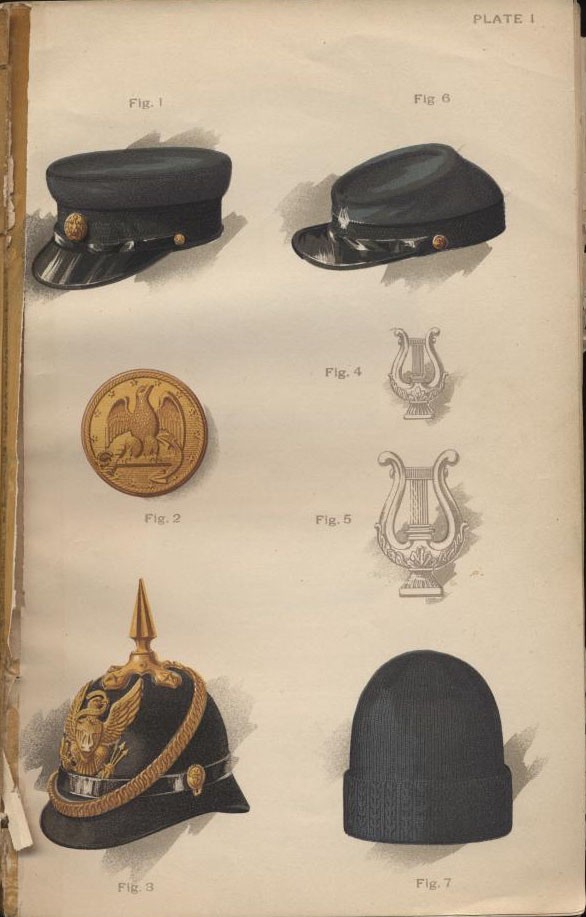
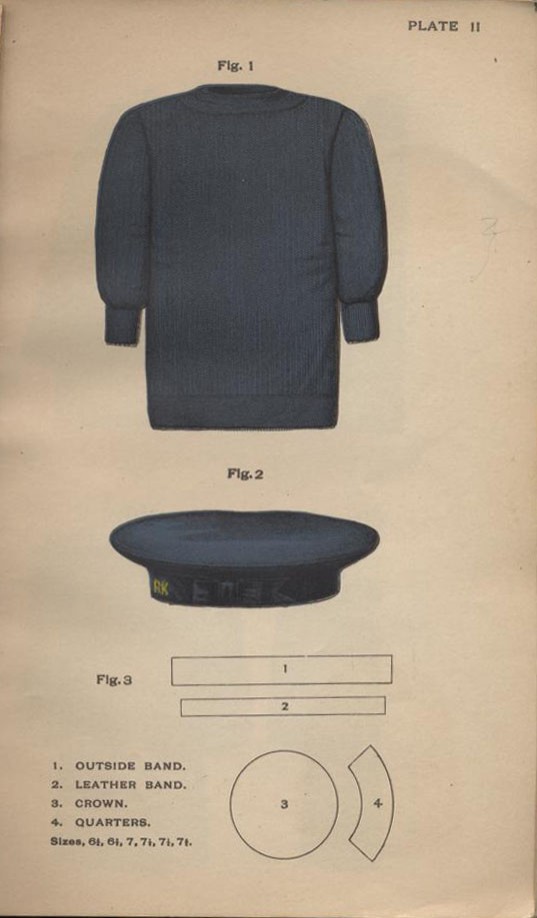
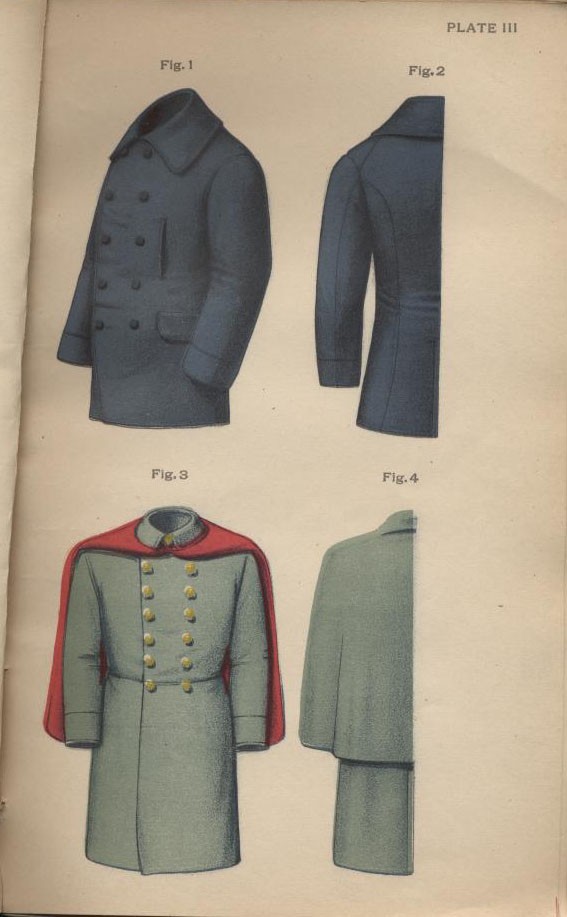
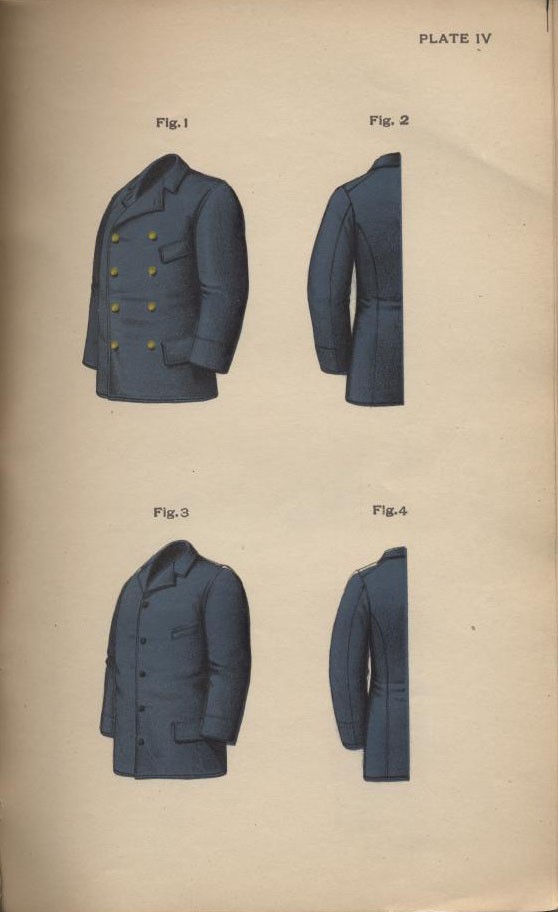
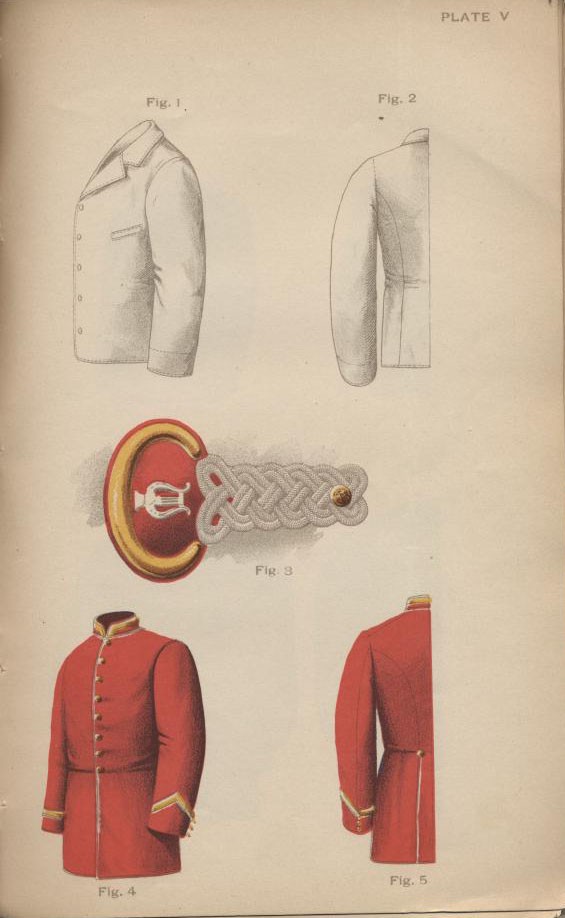
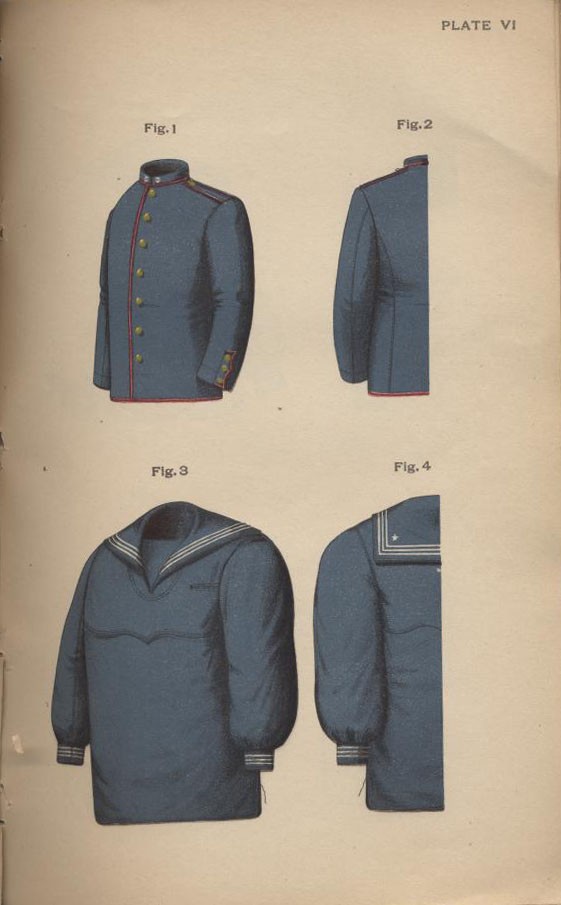
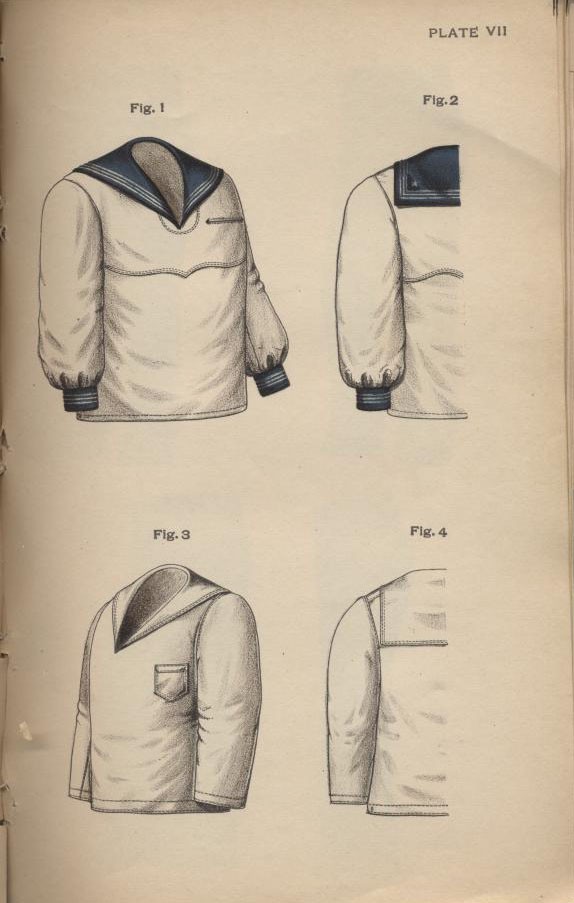
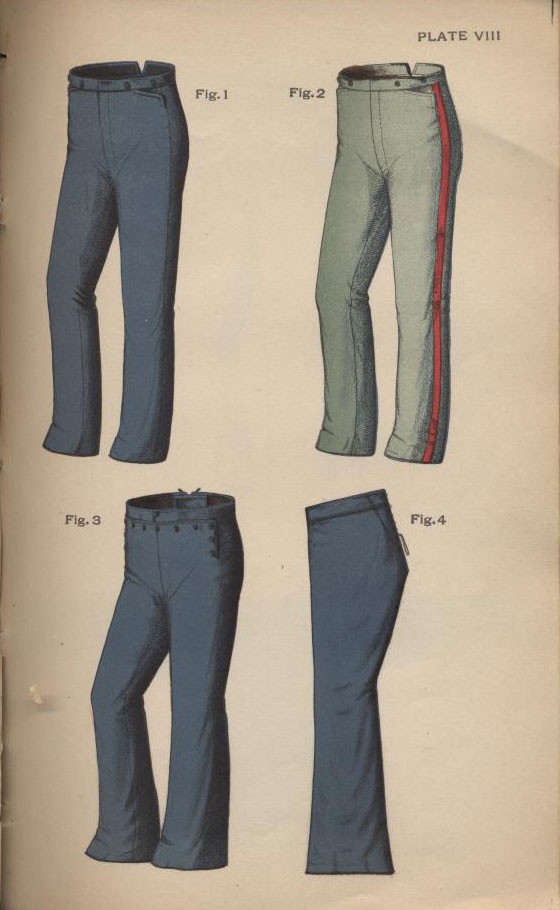
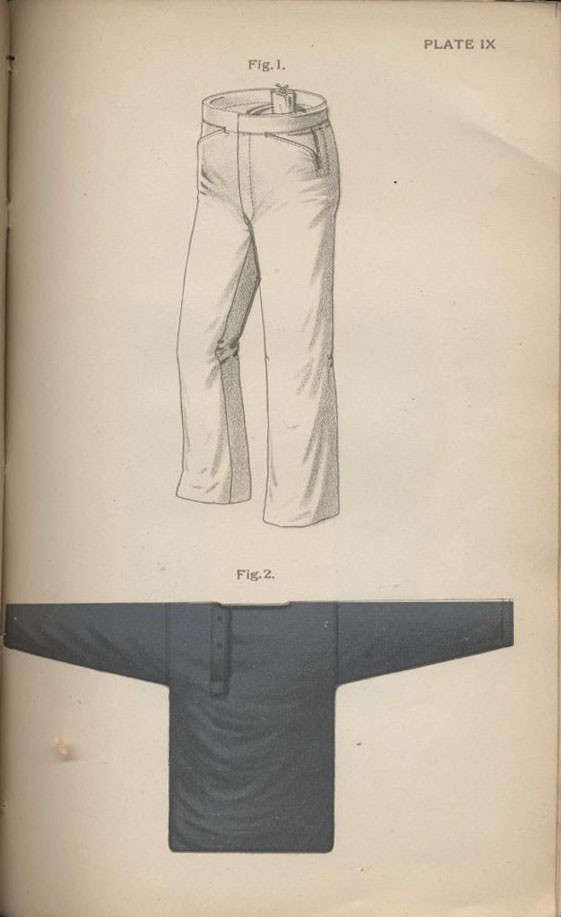
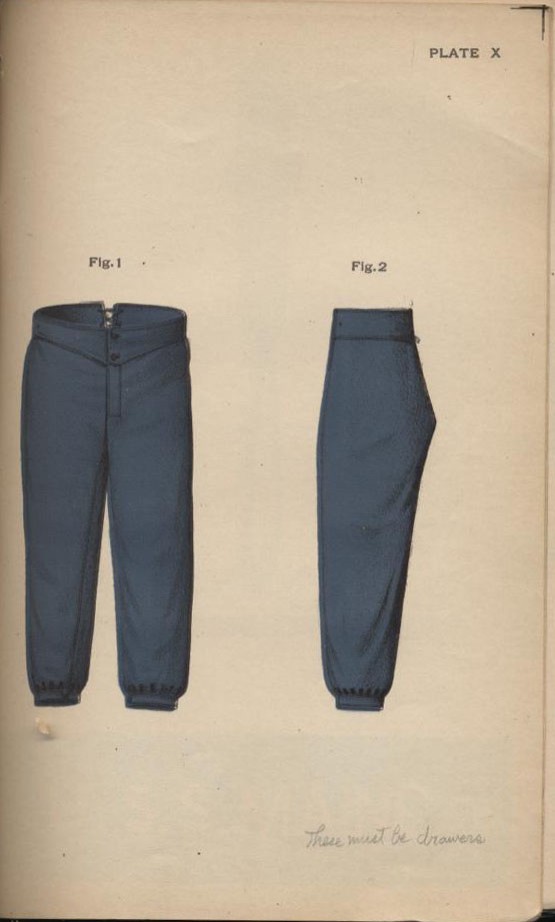
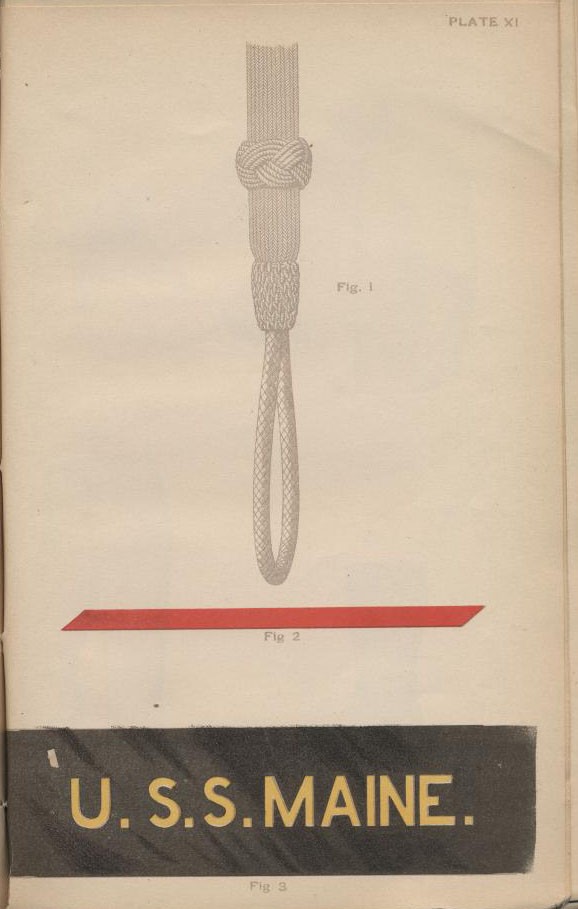
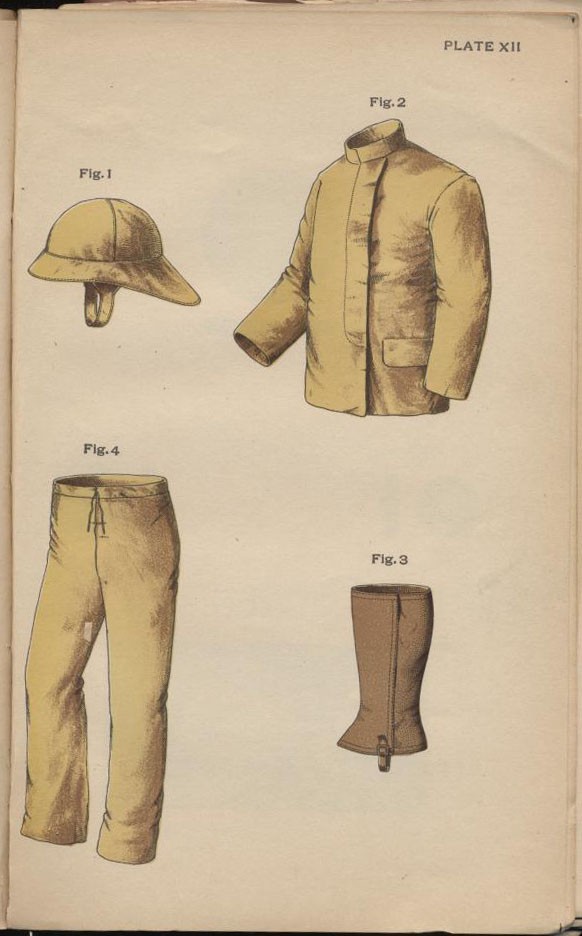
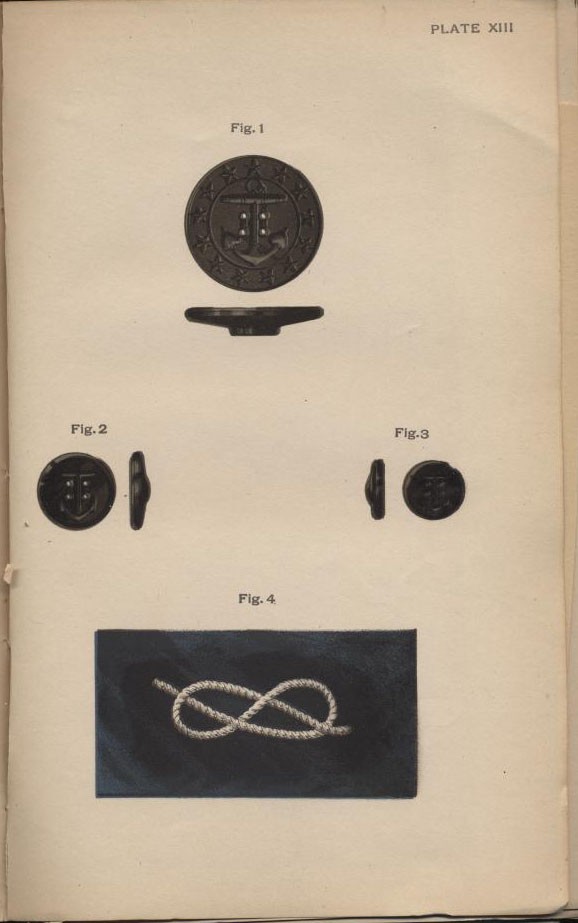
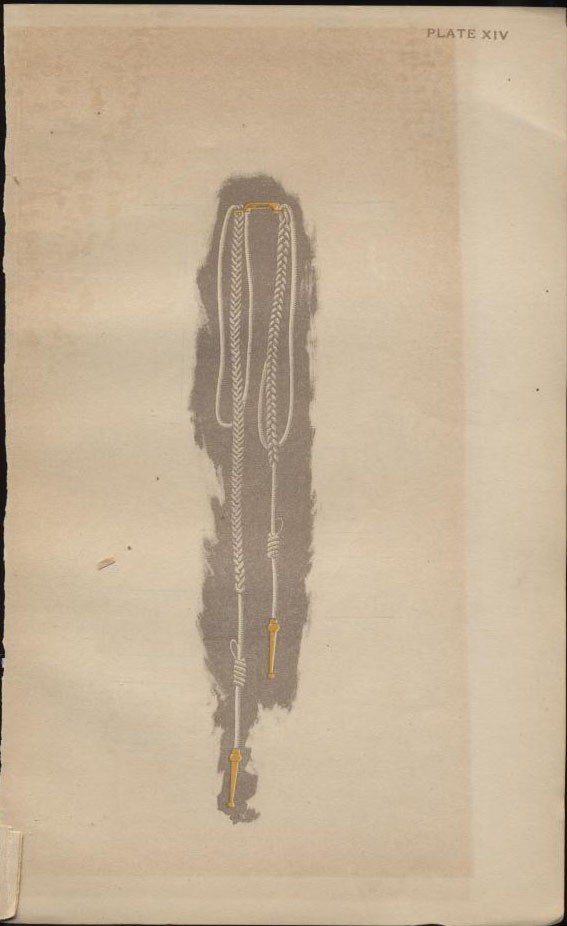
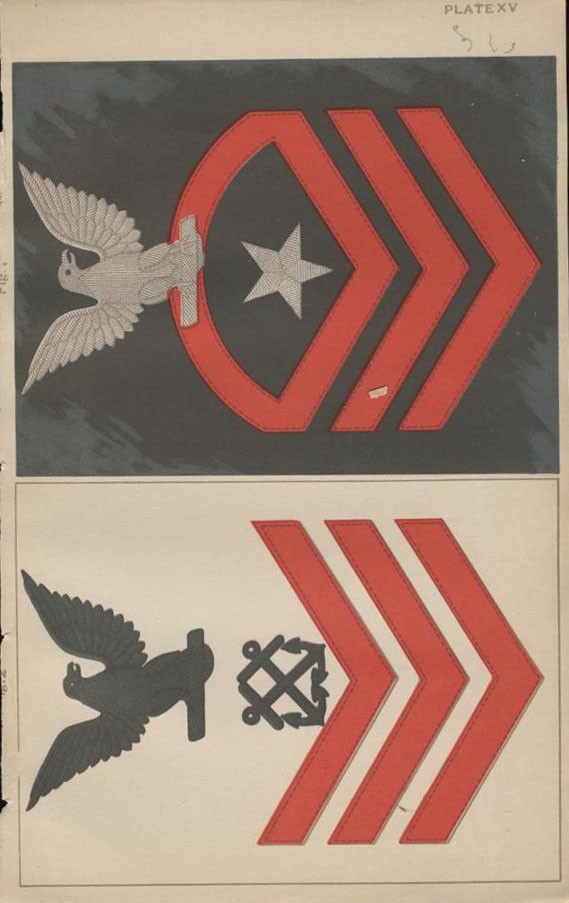
![1470415593912[1].gif 1470415593912[1].gif](/content/history/nhhc/research/library/online-reading-room/title-list-alphabetically/r/regs-governing-uniform-commissioned-officers-1897/_jcr_content/body/image_1646953567.img.gif/1470415610026.gif)
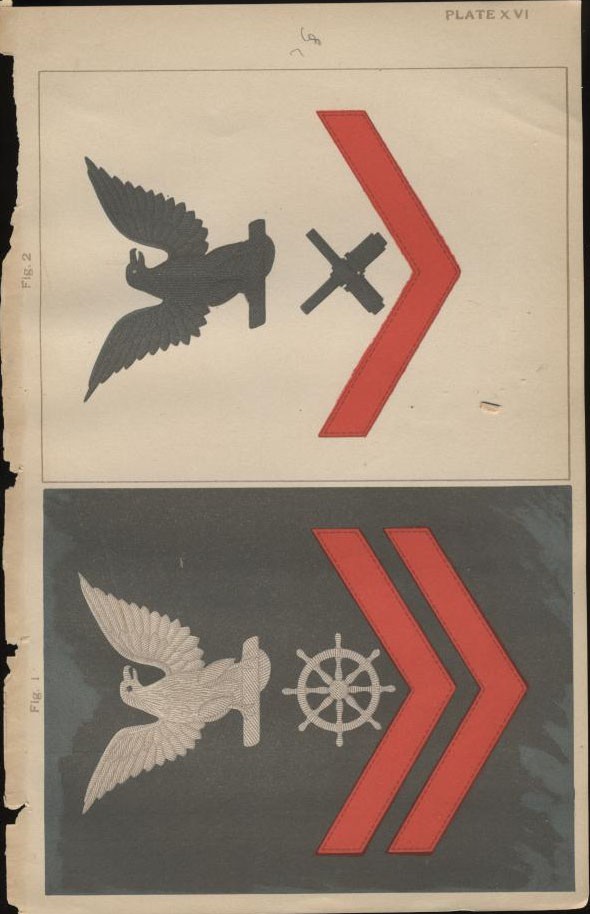
![1470415593912[1].gif 1470415593912[1].gif](/content/history/nhhc/research/library/online-reading-room/title-list-alphabetically/r/regs-governing-uniform-commissioned-officers-1897/_jcr_content/body/image_354886616.img.gif/1470415599855.gif)
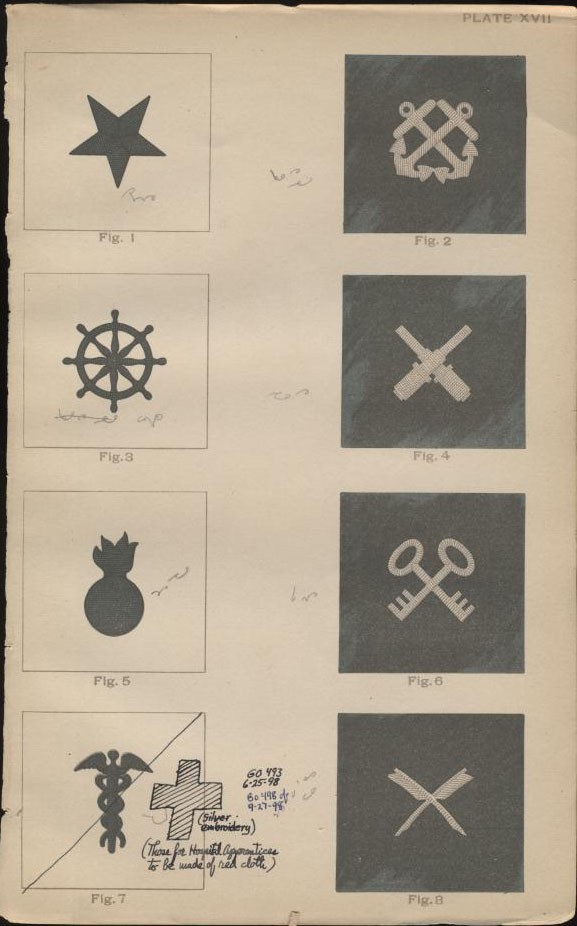
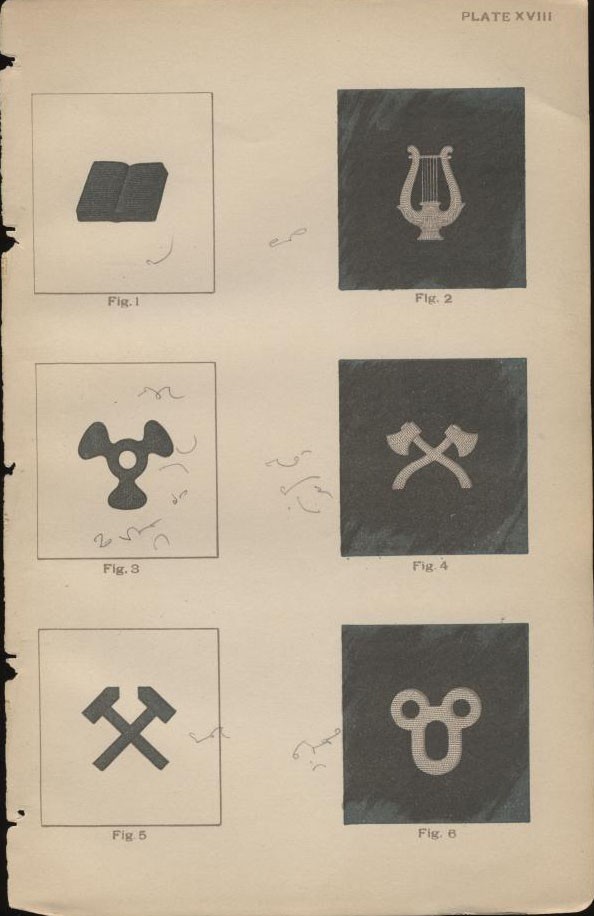
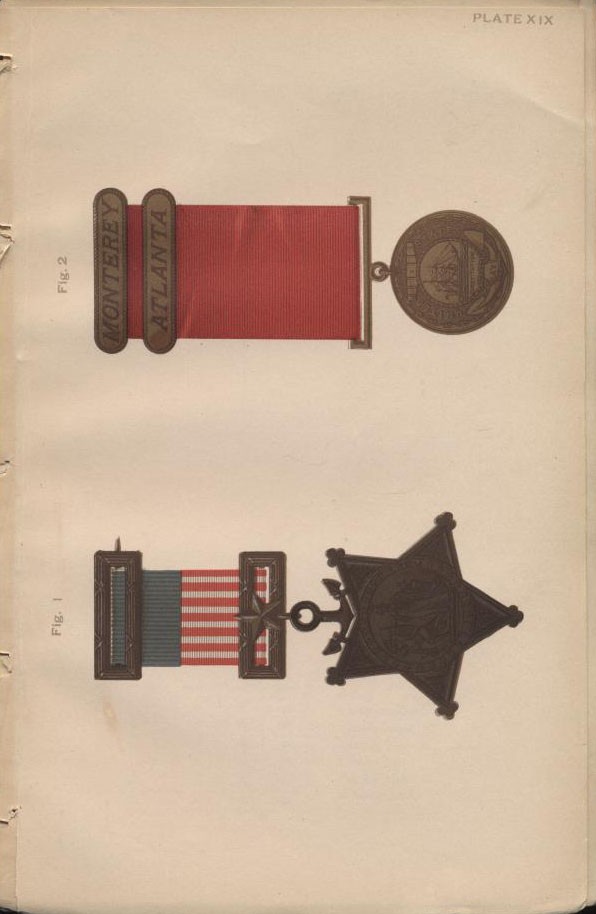
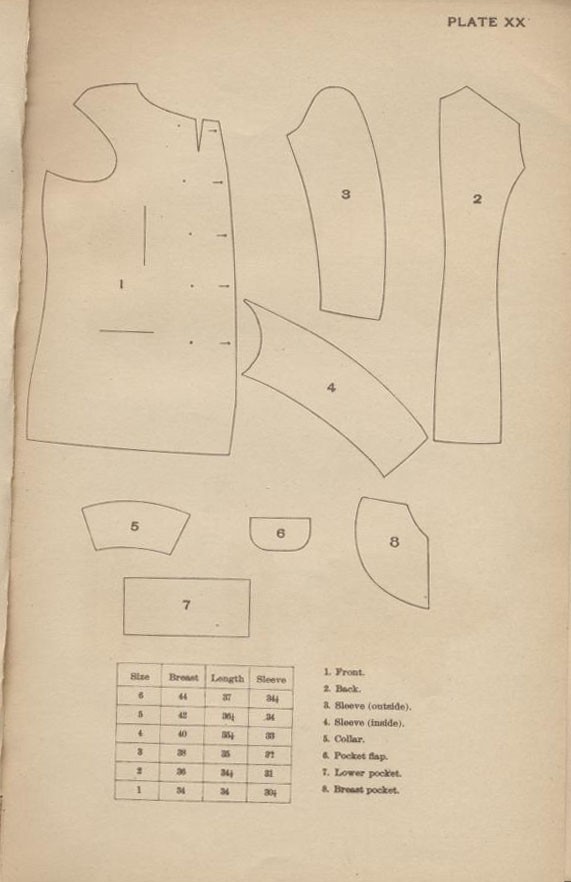
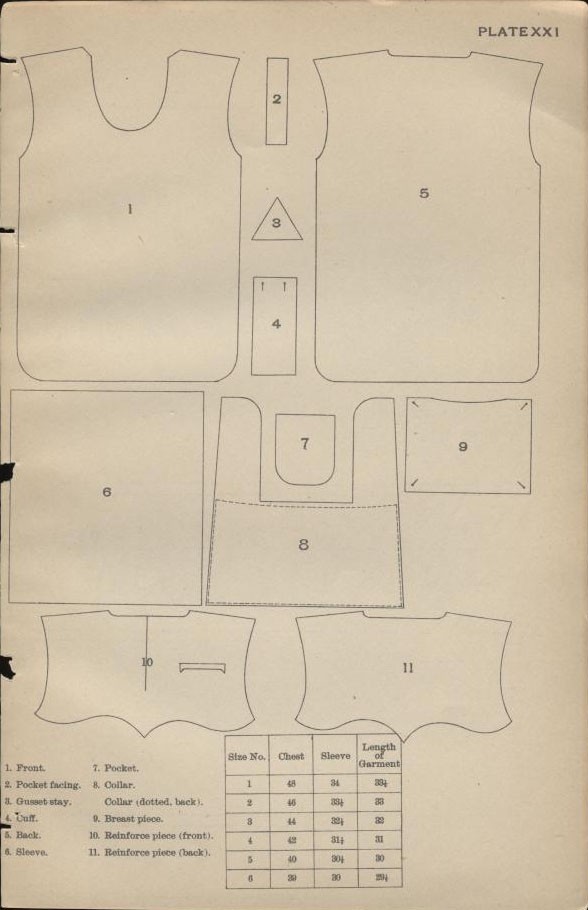
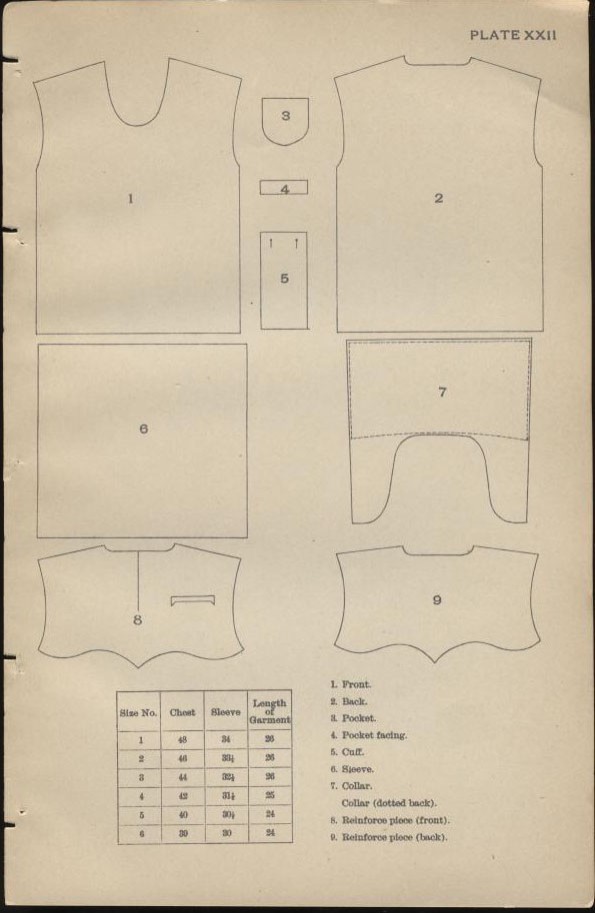
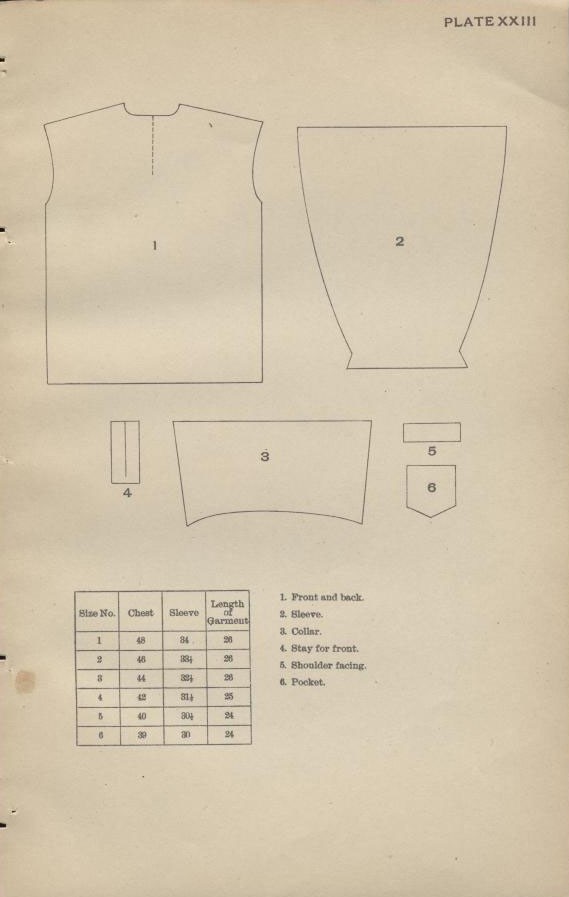
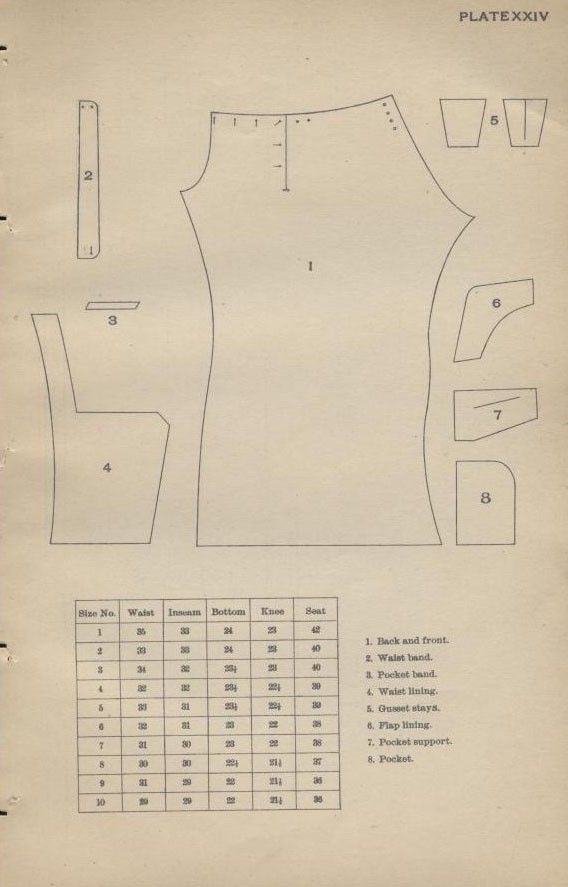
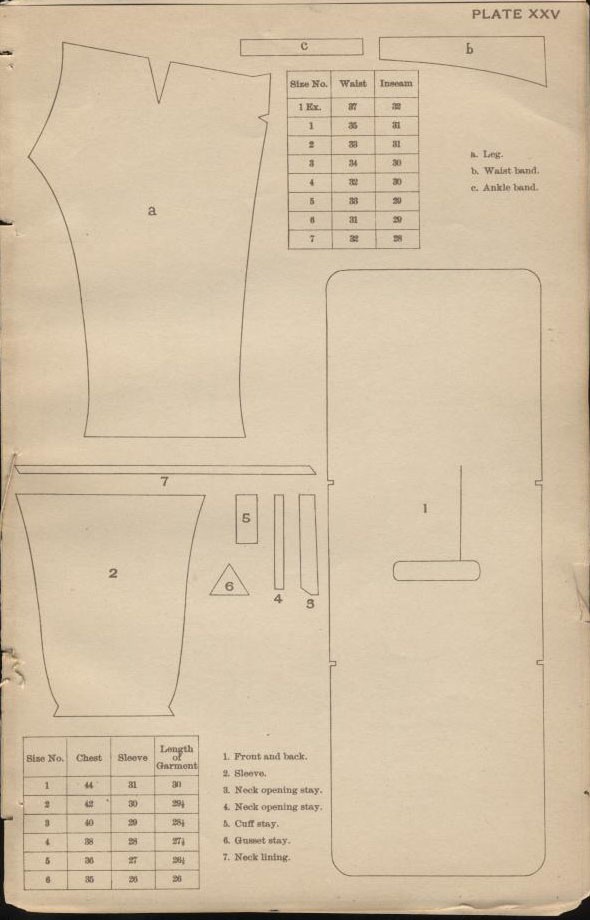
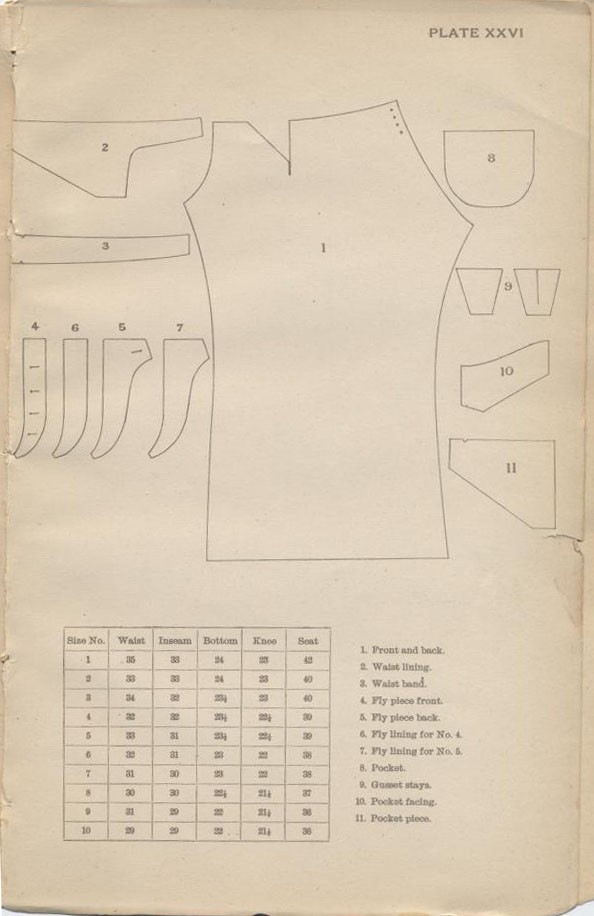
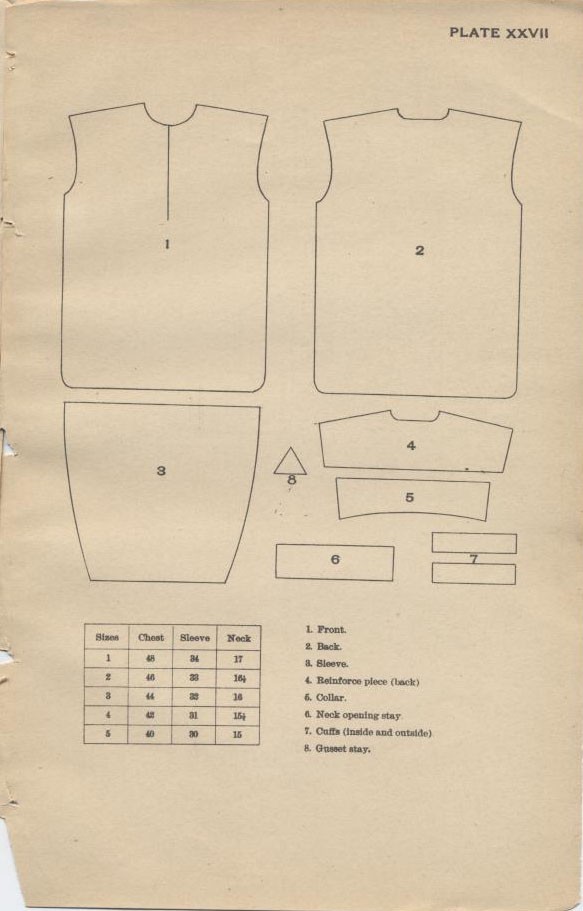
[END]



